The Painful Truth About Stagecoach Travel In The Old West
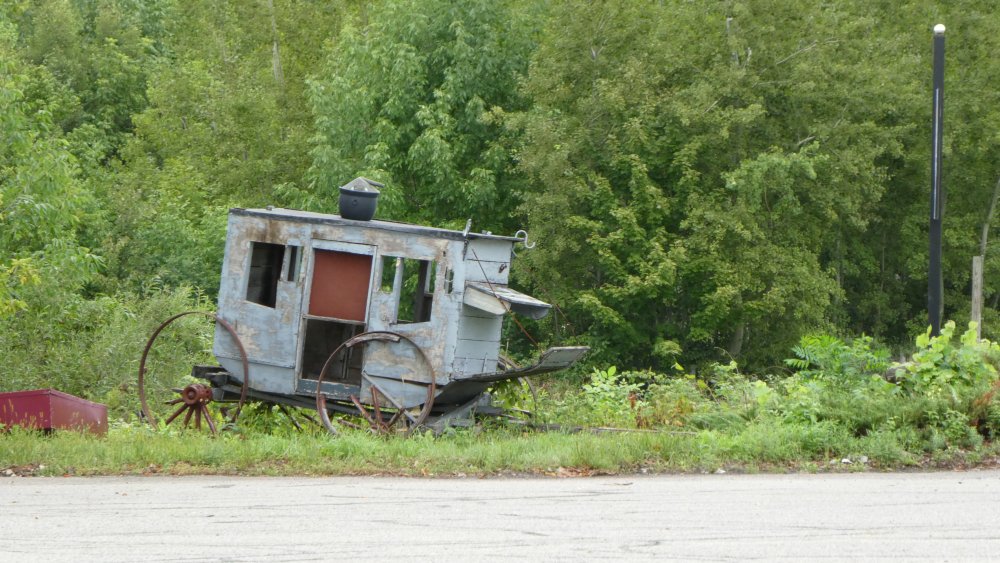
Ah, the Old West, when men were men and women were women and you could tell the hero from the villain by the color of the hats. Ah, the Old West , before the invention and common use of things like deodorant, mouthwash, shampoo, and without frequent (let alone daily) access to things like showers, bathtubs, or perhaps even a wash basin. Or laundry facilities. Or daily changes of clothing. Or any of a hundred other things we take for granted in the United States today.
All of those things should be remembered when the romance of stagecoach travel comes to a grinding halt and reality rears up. Stage travel was one way to get from Point A to Point B or even Q in the Old West — stage companies hired drivers, guards, and set up waystations along the route for changes in horses and brief rest periods, perhaps even a meal. But as True West Magazine tells us, passengers were often packed together in ways that made good friends of total strangers, whether they wanted to be or not. A simple stage supposedly held up to nine adult passengers, but that was if everyone's legs and knees were intertwined.

No shampoo, either
And a stage could carry more people, providing the rider was willing to cling to the railings amid luggage lashed to the top. A stage moved at a fair gait, depending on the terrain, of course — we're talking dirt paths, and an unpaved road, at best. Some stages covered over 100 miles in a day. For a particularly grueling uphill grade, the horses were at a slow walk and passengers had to get out and walk themselves, to lessen the load. Those were the times when the stage was most vulnerable to robbery . Unlike the movies, nobody wanted to chase a stagecoach on a horse at a dead run when you could calmly step in front of it while it was inching along. Robberies were not uncommon, but they weren't the norm, either. Stage passengers could be victims, but usually thieves were after money or gold being transported, especially by stages operated by Wells, Fargo. Stagecoaches usually had a driver and also an armed guard armed with a sawed-off .12-gauge — hence "riding shotgun" — but even so, that wasn't always deterrent. The coaches themselves were not always the enclosed vehicles seen in movies — often they had canvas sides stretched over supports; though there were springs, the coaches' had little or nothing in the way of shock absorbers, and no windows to let fresh air in or keep dust or weather out.
Despite what the movies might tell us, all in all, it was a miserable, messed up way to travel.
The Stagecoach in 1860s
The passenger experience - by jay w. sharp.
John Ford's motion picture, Stagecoach , his classic 1939 cinematic parable of the Old West, virtually defined the image we carry in our mind's eye of nineteenth century stagecoach transportation in the Southwest. This includes John Butterfield's Overland Mail Company stagecoach service, which connected St. Louis, Missouri, and Memphis, Tennessee, with San Francisco, California.

Ford’s six passengers, plus the conductor and driver, traveled through the Southwestern deserts in a finely crafted Concord coach, drawn by three pairs of beautiful horses over a spectacular route through Monument Valley. The passengers rode three abreast within the coach, in facing, padded leather seats. They had ample room for their legs and an exterior boot for their baggage and the mail. They stopped for unhurried meals and rest at way stations. They suffered only briefly from dust and snow storms. They fretted about Geronimo’s marauding Apaches.
Ford gave us unforgettable cinema, but entirely forgettable history. Butterfield’s passengers, not six but usually nine, plus conductor and driver, crossed the Southwestern deserts, not in a fine Concord, but in the much lighter, bone-jarring Celerity (a synonym for "quickness") coach, drawn, not by three pairs of beautiful horses, but usually by two pairs of raw-boned mules. They traveled, not through Monument Valley, in southeastern Utah, but through the Chihuahuan Desert of western Texas and southern New Mexico, the Sonoran Desert of southern Arizona, and the Colorado Desert of southern California.
The passengers rode three abreast, squeezed into back and middle rows, both facing forward, and into a forward row, facing rearward. The facing passengers in the forward and middle rows had to ride with their knees dovetailed. All the passengers rode with baggage on their laps and mail pouches beneath their feet. They travelled relentlessly, day and night, with no more than brief moments at way stations for often poor food and no rest. They suffered, not from brief dust and snow storms, but from continual heat and choking dust in the summer and intense cold and occasional snow in the winter. Like Ford’s passengers, Butterfield’s passengers worried about the Indians, although not about Geronimo, who appeared as an Apache leader, far south of Monument Valley, nearly two decades after Butterfield terminated his service across the Southwest.

A through passenger paid two hundred dollars (equivalent to about three thousand dollars today) for a ticket. He expected to arrive at his destination after some twenty five days of ceaseless travel. A modern passenger, by contrast, can buy an airline ticket for transportation from St. Louis to San Francisco for three hundred dollars, and can expect to make the journey in as little as four hours or so.
William Tallack, an English cleric who traveled from San Francisco to St. Louis on the Butterfield line in the summer of 1860, said that a passenger awaiting departure worried about "how far he might be able to endure a continuous ride...with no other intermission than a stoppage of about forty minutes twice a day, and a walk, from time to time, over the more difficult ground...with only such repose at night as could be obtained whilst in a sitting posture and closely wedged in by fellow-travellers and tightly-filled mail-bags."
There was, said Tallack, "no absolute security against" Indian attack, "whilst murders and robberies were known to be of constant occurrence along the line...in the cases of solitary or incautious travellers...
"A third ground for apprehensive anticipation was the extreme liability of vehicles to overset [overturn] during a journey through regions possessing no macadamized roads, and often only a route the most rugged and steep. In case, too, of any accident or illness...there was the certainty of being placed in a very unpleasant position..."

A San Francisco Daily Evening Bulletin Special Correspondent, who made the trip from San Francisco to St. Louis in 1858, said that, "All the traveler needs to render himself comfortable is a pair of blankets, a revolver or knife (just as he fancies), an overcoat, some wine to mix with the water, (which is not of the sweetest quality) and three or four dollars’ worth of provisions...
"Arms are not furnished the passengers by the Company," the correspondent cautioned.
"Were I to make the trip again," he said, "I would take...the stoutest suit of clothes I could get, with a strong, loose pair of boots..."
Butterfield’s passengers seldom found that a trip equaled their forebodings.
It was worse.
Raphael Pumpelly, who traveled on Butterfield’s line west to Tucson, said, "The coach was fitted with three seats, and these were occupied by nine passengers. As the occupants of the front and middle seats faced each other, it was necessary for these six people to interlock their knees; and there being room inside for only ten of the twelve legs, each side of the coach was graced by a foot, now dangling near the wheel, now trying in vain to find a place of support. An unusually heavy mail in the boot, by weighing down the rear, kept those of us who were on the front seat constantly bent forward...
"The fatigue of uninterrupted traveling by day and night in a crowded coach, and in the most uncomfortable positions, was beginning to tell seriously upon all the passengers, and was producing in me a condition bordering on insanity..."
Watterman L. Ormsby, a reporter for the New York Herald and the only through passenger on the Butterfield’s maiden westbound trip, in 1858, reported that a run up the east side of the Pecos River to a crossing passed over a trail "along the edge of the plain, thumping and bumping at a rate which threatened not to leave a whole bone in my body. What with the dust and the sun pouring directly on our heads...I found that day’s ride quite unpleasant..."
The English cleric Tallack, his coach stopped for a change of teams at a way station in southern Arizona, said that, "Today, on having a relay of mustangs, they reared up and plunged worse than usual, broke the pole-chain, stood up nearly perpendicularly, and, finally, one fell and got underneath the body of the waggon, which movement, together with the threatening kicks and jerks of the animal, caused our speedy evacuation of the vehicle..."
The New York Herald reporter, Ormsby, his coach ascending the rugged trail westward up to the pass at the south end of Texas’ Guadalupe Mountains, said, "We were obliged actually to beat our mules with rocks to make them go the remaining five miles to the [way] station, which is called the Pinery..." The correspondent, his coach approaching the Guadalupe Pass from the west on a cold November said, "...we were informed by the driver that we were near a lay of sand four miles in length, and that we must walk through if we expected ever to arrive at our next station...the Pinery... Scarcely had we commenced our tramp on foot, before the young moon was veiled in a fleecy mist, which came down upon us poor devils and continued to play away upon our dusty hats and blankets until we had plodded our weary way four miles through the deep and heavy sand..."
"Meals (at extra charge) are provided for the passengers twice a day," said Tallack. "The fare, though rough, is better than could be expected so far from civilized districts, and consists of bread, tea, and fried steaks of bacon, venison, antelope, or mule flesh—the latter tough enough."
For breakfast at a way station in West Texas, Ormsby had "jerked beef (cooked on the [buffalo] ‘chips’), raw onions, crackers slightly wormy, and a bit of bacon."
Butterfield warned his passengers at the outset of a trip with a poster that said:
YOU WILL BE TRAVELING THROUGH INDIAN COUNTRY AND THE SAFETY OF YOUR PERSON CANNOT BE VOUCHSAFED BY ANYONE BUT GOD.
Passengers and crew readied their weapons at the slightest sign of Indians, especially in the Mescalero Apache country of West Texas and the Chiricahua Apache regions in Southern New Mexico and Arizona.
At way stations east of Tucson, the correspondent noted, "Rifles, shot-guns, revolvers and muskets, heavily charged, and at convenient places are the objects that first strike attention..."
The conductor and driver saw Apaches encamped beside the trail during a night passage through southern New Mexico and, "When their campfires were first seen, the conductor immediately awoke the passengers, and rifles and revolvers were drawn from their holsters ready for instant use..."
"At Gila Bend, Sutton’s ranch, we saw a dead Apache Indian, tied in a standing posture to a tree," said H. D. Barrows who traveled across southern Arizona en route to Missouri in late 1860. "He had been shot by Sutton’s son, a lad of about fourteen..."
In spite of hardships and fears, Butterfield’s passengers sometimes found exhilaration in their adventure across the deserts of the Southwest.
"The Apache Pass was a rugged but very picturesque portion of our route," said Tallack, "and will be long remembered by the writer as the scene of the finest storm and sunset he ever witnessed."
"The rocks at this station [Hueco Tanks, about thirty miles east of El Paso] are visible for a distance of twenty miles on the plain," said the correspondent. "When they are reached they present a most wild and imposing aspect. Cathedral-like in shape, they appear as though pushed up out of the earth in a confused mass of solidity..."
"...I shall never forget," said Ormsby of his passage by the Guadalupe Mountains, "the gorgeous appearance of the clouds: tinged by the setting sun above those jagged peaks, changing like a rapid panorama, they assumed all sorts of fantastic shapes, from frantic maidens with dishevelled hair to huge monsters of fierce demeanor, chasing one another through the realms of space."
Butterfield’s employees, said Ormsby, "I found, without exception, to be courteous, civil, and attentive... I found the drivers on the whole line, with but few exceptions, experienced men. Several are a little reckless and too anxious to make fast time, but as a generally thing they are very cautious."
At the end of his journey, Barrows reflected, "To many people, doubtless, who think more of their ease than they do of robust physical health, a stage ride of a thousand or two thousand miles, may seem a very formidable undertaking. But for those who had a liking for adventure, and a desire to see something of the world, a long ride of two or three weeks, practically in the open air, not in hot, stuffy cars, possesses a wonderful charm, especially in remembrance..."
For additional reading about the Butterfield Overland Mail Company, see the following:
Bishop, C. C. Frontier Stories of the Lone Star State. Self Published, 1936.
Butterfield Overland Mail. Website, Internet.
Conkling, R. P. and Conkling, M. B. The Butterfield Overland Mail, 1857-1869, Volume I. Glendale, California, The Arthur H. Clark Company, 1947.
DesertUSA.com. Website, Internet.
Giddings, E., Mahon, W. and Kielman, C. V. "George H. Giddings and The San Antonio-San Diego Mail Line." Southwestern Historical Quarterly, Volume LXI, July, 1957 to April 1958. pp 220-239.
Greene, A. C. 900 Miles on the Butterfield Trail. Denton, Texas, University of North Texas Press, 1994.
Hilton, W. H. Sketches in the Southwest and Mexico 1858-1877. Los Angeles, Dawson’s Book Shop, 1963.
Hollon, W. E. The Southwest: Old and New. New York, Alfred A. Knopf, 1961.
Kurtz, D. and Goran, W. D. Trails of the Guadalupes: A Hiker’s guide to the Trails of Guadalupe Mountains National Park. Champaign, Illinois, Environmental Associates, 1992.
Lang, W. B. (Editor) The First Overland Mail, Butterfield Trail, St. Louis to San Francisco, 1858-1861. East Aurora, New York, Roycrofters, 1940.
Farwell, J. M. "Correspondence to the Daily Alta California, 1858." pp 111-127. Tallack, W. "The California Overland Express: The Longest Stage Ride in the World," pp 129 to 157.
Lang, W. B. (Editor) The First Overland Mail, Butterfield Trail, St. Louis to Memphis, 1858-1861. East Aurora, New York, Roycrofters, 1945.
Special Correspondent, "Notes of Travel by the Overland Mail for the San Francisco Daily Evening Bulletin." pp 13-45.
Pumpelly, R. "A Journey by Stage-Coach to Arizona." pp 54-62.
Barrows, H. D. "A Two Thousand Mile Stage Ride." pp 64-70.
Ormsby, W. L., The Butterfield Overland Mail. San Marino, California, The Huntington Library, 1998.
Richardson, R. N. "Some Details of the southern Overland Mail." Southwestern Historical Quarterly, Volume XXIX, July, 1925. pp 1-18.
The Texas State Historical Association. Handbook of Texas Online. Joint Project of The General Libraries at the University of Texas at Austin and the Texas State Historical Association, 1997-1999. Website, Internet.
Twain, M. Roughing It. Pleasantville, New York, Reader’s Digest Association, 1994.
Williams, J. W. "The Butterfield Overland Mail Road Across Texas." Southwestern Historical Quarterly, Volume LXI, July, 1957. pp 1-19.
Related DesertUSA Pages
John Butterfield (Has a map of the route) Vallecito Stage Coach Days

How to Keep Ice Cold in the Desert

Desert Survival Skills

Get the Best Hotel and Motel Rates

26 Tips for Surviving in the Desert
Share this page on Facebook:
DesertUSA Newsletter -- We send articles on hiking, camping and places to explore, as well as animals, wildflower reports, plant information and much more. Sign up below or read more about the DesertUSA newsletter here . (It's Free.)
FREE DESERTUSA NEWSLETTER
Enter E-Mail address:
The Desert Environment The North American Deserts Desert Geological Terms
Enter Email:

Home | About | Contact Us | Feedback | Privacy | Site Outline | Advertising on DesertUSA | Hotels

A Journey Through Time: Exploring the Iconic 19th Century Stagecoach
Welcome to my blog, 19th Century ! In this article, we will delve into the world of stagecoaches during the 19th century . Explore the thrill of traveling through rugged landscapes, the luxury experienced by some passengers, and the challenges faced by those who operated these iconic modes of transportation. Join me as we step back in time to experience the golden age of stagecoach travel.
Table of Contents
The Evolution of Stagecoaches in the 19th Century: Transforming Transportation in the Old West
The evolution of stagecoaches in the 19th century was a pivotal development that transformed transportation in the Old West. Stagecoaches, also known as stagecoaching , were horse-drawn vehicles specifically designed for carrying passengers and mail over long distances.
During the early 19th century, stagecoaches were simple and basic in design. They were typically made of wood and had two or four wheels, depending on the terrain they would traverse. The comfort and safety of passengers were not major concerns at this time, as the primary focus was on getting from one point to another as quickly as possible.
However, as the century progressed, stagecoach companies started to recognize the importance of passenger comfort and safety. This led to significant improvements in design . Stagecoaches were now built with stronger frames, better suspension systems, and more comfortable seating arrangements.
One of the most important developments during this time was the introduction of the Concord Coach. Built by the Abbot-Downing Company, the Concord Coach became the iconic symbol of stagecoaching in the American West. It featured a strong but lightweight body, flexible leather thoroughbraces for a smoother ride, and high, sturdy wheels capable of navigating rough terrain.
The increased efficiency and reliability of stagecoaches made them an essential mode of transport in the Old West. They played a crucial role in connecting isolated settlements and mining camps, allowing for the transportation of goods, mail, and people across vast and often treacherous landscapes.
However, stagecoaching faced numerous challenges in the late 19th century , particularly with the advent of the transcontinental railroad . The faster, more efficient steam-powered locomotives threatened the dominance of stagecoaches as the primary means of transportation. The decline of stagecoaching was further accelerated with the arrival of automobiles in the early 20th century.
Nevertheless, the legacy of stagecoaching in the 19th century remains significant. It represented a major leap forward in transportation technology and played a significant role in the settlement and development of the American West. The ingenuity and craftsmanship behind the design of stagecoaches continue to captivate and inspire people to this day.
Top 20 Must-Watch Medieval TV Shows
Royal library | rain and thunderstorm sounds on study ambience with crackling fireplace, what was a stagecoach during the 1800s.
A stagecoach during the 1800s was a type of horse-drawn carriage used for transportation on long distance routes. It was a vital mode of transportation in the 19th century, especially in regions where railways were not yet established. Stagecoaches were typically made of wood and had four wheels, with a curved roof and windows. They had an enclosed passenger compartment, called the coach box , which was divided into several rows of seats. The exterior of the stagecoach was often adorned with colorful paint and elaborate decorations. A team of horses would be harnessed to the stagecoach, and they were frequently changed at stage stations along the journey. Drivers, commonly known as whipmen , controlled the horses and navigated the stagecoach along rough and sometimes treacherous roads. Stagecoaches provided transportation for passengers, mail, and sometimes even goods or gold during the 1800s.
What was the passenger capacity of a stagecoach?
The passenger capacity of a stagecoach in the 19th century varied depending on the size and design of the coach. In general, a typical stagecoach could accommodate around 8 to 12 passengers. However, larger coaches known as “six-horse coaches” or “mud wagons” could carry up to 20 passengers. It’s important to note that the passenger capacity could also be influenced by the distance of the journey, as some coaches had limited seating for long-distance trips to maximize passenger comfort and space.
What made stagecoach rides so uncomfortable?
Stagecoach rides in the 19th century were often extremely uncomfortable due to a variety of factors. Firstly, the roads during that time were generally unpaved and rough, resulting in a bumpy and jarring journey for passengers. The constant jolting and bouncing of the coach made it difficult for travelers to find a comfortable position or get any rest during the ride.
Another factor contributing to the discomfort was the lack of suspension in early stagecoaches. These vehicles were typically equipped with minimal cushioning, if any, making it feel like sitting on a hard wooden bench. The absence of a proper suspension system meant that every bump and uneven patch on the road was felt directly by the passengers, leading to a rather unpleasant experience throughout the journey.
The cramped seating arrangement was yet another cause of discomfort. Stagecoaches were designed to carry as many passengers as possible, often packing them tightly together. This meant that travelers had very limited space and were forced to sit in close proximity to other passengers for extended periods. The lack of personal space and privacy only added to the overall discomfort.
Furthermore, the dust and dirt generated by the movement of the stagecoach were significant issues. The roads were often dusty, especially during dry weather, and the wheels of the coach would stir up clouds of dirt and debris. This resulted in poor air quality inside the stagecoach, making breathing difficult and causing passengers to become dirty and covered in grime.
Despite these discomforts, stagecoach travel remained a popular mode of transportation in the 19th century due to the lack of alternatives. It provided a means of long-distance travel and played a vital role in connecting communities. However, it cannot be denied that the conditions and experiences of stagecoach rides were far from pleasant and could be quite arduous for passengers.
What was it like to travel in a stagecoach?
In the 19th century, traveling in a stagecoach was a common mode of transportation, especially in rural areas where other options were limited. Stagecoaches were essentially large horse-drawn carriages that could accommodate several passengers and their luggage.
The experience of traveling in a stagecoach was certainly not luxurious. The roads were often bumpy and uneven, causing passengers to endure a rough journey. Inside the stagecoach, seating was typically cramped, with narrow benches or seats facing each other. There were no shock absorbers, so passengers would feel every jolt and bump along the way.
Stagecoach travel was also quite slow. The average speed was around 5-6 miles per hour, which meant that long-distance journeys could take several days. The speed was dependent on various factors such as weather conditions, road quality, and the condition of the horses.
Passengers would often have to endure uncomfortable conditions during their journey. The stagecoach did not provide much protection from the elements, so travelers were exposed to rain, wind, dust, and extreme temperatures. In some cases, there might not even be windows to shield them from these outdoor elements.
Additionally, stagecoach travel was often crowded and noisy. Passengers would share the space with fellow travelers and their belongings, leading to cramped quarters. The sound of the horse hooves, creaking carriage, and conversations among passengers would create a constant background noise throughout the journey.
Despite the discomforts and challenges, traveling in a stagecoach had its advantages. It provided a means of transportation for those who did not own a horse or carriage. It also allowed passengers to interact with people from different backgrounds and social classes, creating opportunities for conversation and connections.
Overall, traveling in a stagecoach in the 19th century was a physically demanding and sometimes uncomfortable experience. However, it played a significant role in connecting people and communities in a time when other modes of transportation were limited.
Frequently Asked Questions
How did stagecoaches in the 19th century contribute to the expansion and development of the american west.
Stagecoaches in the 19th century played a crucial role in the expansion and development of the American West.
They provided an essential means of transportation, allowing people to travel long distances across the vast and often remote landscapes of the West. This facilitated the settlement of new territories and the establishment of towns and trading posts.
Stagecoach routes were established, connecting various parts of the West and offering regular transportation for both passengers and goods. These routes became vital lifelines, enabling trade and communication between different regions. They were essential for linking the isolated communities that were beginning to dot the frontier with the larger towns and cities of the region.
Furthermore, stagecoaches also played a significant role in the mail delivery system . They transported mail between settlements and provided a reliable connection to the rest of the country. This improved communication and allowed for the exchange of information and news, fostering social and economic development in the West.
Stagecoach lines were often accompanied by the establishment of stations or stops along the routes. These stations served as places for stagecoaches to change horses, allowing for continuous travel without the need for long breaks. They also provided services such as food, lodging, and repair facilities for travelers, creating opportunities for economic activity and the growth of businesses.
The presence of stagecoaches and the development of transportation networks also had a broader impact on the West’s economy. They stimulated commerce and trade by making it easier for merchants to transport goods and connect with markets. Additionally, the demand for supplies and services to support stagecoach operations, such as horse breeding and feeding, contributed to the growth of local economies.
Overall, stagecoaches were instrumental in promoting the expansion and development of the American West in the 19th century. They provided a reliable means of transportation, facilitated trade and communication, and helped connect isolated communities with the rest of the country.
What were the typical routes and destinations of stagecoaches during the 19th century?
In the 19th century, stagecoaches were an important mode of transportation for both people and goods. They followed specific routes that linked towns and cities, connecting various regions across countries. These routes varied based on location, but some common destinations and routes included:
1. East Coast of the United States: Stagecoaches operated along the eastern seaboard, extending from Maine to Florida. They traveled between major cities such as Boston, New York City, Philadelphia, Baltimore, and Washington, D.C.
2. Transcontinental Routes in the United States: Stagecoaches played a crucial role in expanding westward during the settlement of the American frontier. Routes like the California Trail and Oregon Trail facilitated travel to the western states, including California and Oregon.
3. European Routes: In Europe, stagecoach routes connected major cities and towns. For example, in England, the famous London to Edinburgh route provided transportation between these two capital cities.
4. Australian Routes: During the Australian gold rush in the mid-1800s, stagecoach routes developed in various regions, linking goldfields to major towns and ports.
5. South American Routes: Stagecoaches were used in South American countries such as Argentina and Chile, connecting various regions within each country.
It’s important to note that the routes and destinations of stagecoaches evolved over time due to changing needs and advancements in transportation technology, ultimately being replaced by railroads and automobiles.
What were some challenges and dangers faced by stagecoach travelers in the 19th century?
Stagecoach travelers in the 19th century faced numerous challenges and dangers during their journeys.
One of the major challenges was the rough terrain and poor road conditions. Many roads were unpaved, making travel slow and difficult. Stagecoaches often had to navigate through muddy or rocky paths, which increased the risk of accidents and breakdowns.
Banditry and attacks were also significant dangers for stagecoach travelers. Remote areas that were common routes for stagecoaches were often frequented by outlaws and highwaymen who would target these vehicles. Stagecoach robbers would ambush the coaches, demanding money, valuables, or even kidnapping passengers for ransom.
Another challenge was the possibility of accidents due to the speed and lack of safety measures on stagecoaches. The coaches were pulled by horses at high speeds, making it easy for them to tip over or collide with other vehicles. Passengers were not provided with seatbelts or any form of protection, increasing the risk of injuries during accidents.
Harsh weather conditions also posed a threat to stagecoach travelers. Heavy rain and snowstorms could cause delays and make roads impassable. Moreover, extreme temperatures could lead to discomfort or even health issues for passengers exposed to hot or cold weather for extended periods.
Poor sanitation and health hazards were additional challenges for stagecoach travelers. The limited facilities and cramped conditions within the coaches made it difficult to maintain cleanliness. Passengers were often exposed to unsanitary conditions, which increased the risk of diseases such as cholera, typhoid, and dysentery.
Lastly, long and arduous journeys took a toll on the overall physical and mental well-being of the stagecoach travelers. Lack of comfortable seating, constant jostling, and limited rest stops made the journeys exhausting and draining.
Stagecoach travelers in the 19th century faced challenges and dangers such as rough terrain, banditry, accidents, harsh weather conditions, poor sanitation, and health hazards. Despite these risks, stagecoach travel played a significant role in transportation during that era.
The 19th century stagecoach revolutionized transportation and played a pivotal role in shaping the development of the American West. The stagecoach became an iconic symbol of adventure and perseverance, transporting people, mail, and goods across vast distances with remarkable efficiency. It provided a lifeline to isolated communities, connecting them to the rest of the country and fostering economic growth and cultural exchange. However, the era of the stagecoach was not without its challenges, as travelers faced rugged terrain, harsh weather conditions, and the constant threat of bandits. Nevertheless, the stagecoach persevered, leaving an indelible mark on American history. Today, we can still catch glimpses of this bygone era in museum exhibits and movies, reminding us of the incredible ingenuity and determination of those who braved the frontier in the 19th century.
To learn more about this topic, we recommend some related articles:

Exploring the Majestic Artistry: A Glimpse into 19th Century Italian Landscape Painters

The Artistic Brilliance of Hungarian Painters in the 19th Century

Unveiling the Enigmatic World of 19th Century Mediums: Exploring Spiritualism and Supernatural Phenomena
Unveiling the Past: Exploring the 19th Century Newspaper Database

Exploring 19th Century British Literature Jobs in the United States: A Transatlantic Journey
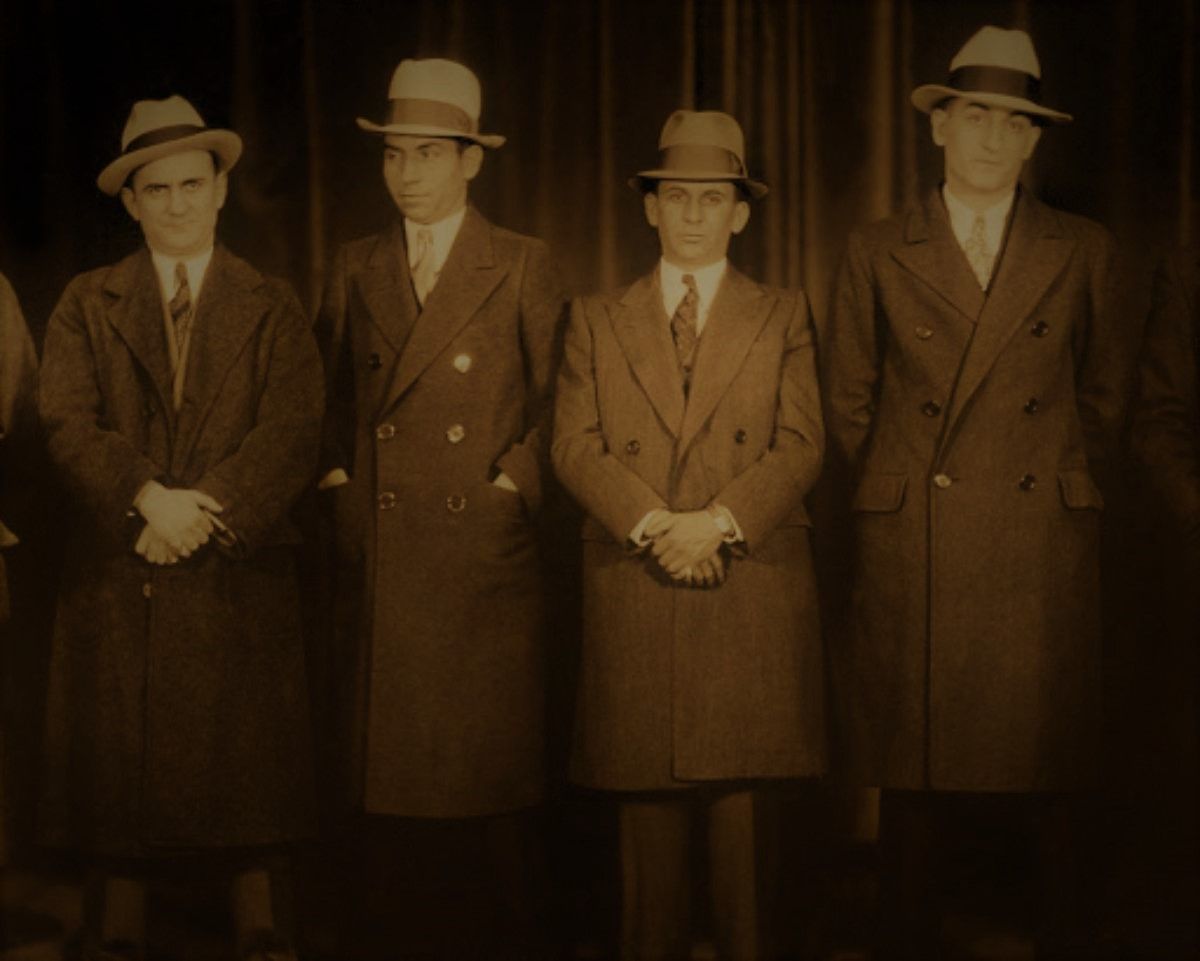
The Rise and Fall of 19th Century Mafia: A Historical Account
- American History
- Ancient History
- European History
- Military History
- Medieval History
- Latin American History
- African History
- Historical Biographies
- History Book Reviews
- Sign in / Join

History of the American Stagecoach
In Hollywood movies, stagecoach rides offer cozy seats and grand views, but in reality, travel by stagecoach was uncomfortable and sometimes dangerous.
In the 1800s American West roads were rocky, rutted, and sometimes impassible by stagecoach without a good push from behind. Bandits were a constant threat and undoubtedly viewed stagecoach passengers like cats watching birds in a cage. On long trips, passengers generally slept sitting up or not at all since it was considered bad etiquette to rest ones head on another passenger. Rest stations, which were called swing stations, were only used to change out horses and rarely offered food. Nevertheless, the stagecoach was a vital method of transportation in the American West, and far more comfortable than riding on horseback.
The Concord Stagecoach
The Concord Stagecoach was built like a basket on leather straps that swung from side to side, weighed more than a ton, and cost somewhere between $1500 and $1800. Concords had a seat in front, in back, and one in the middle seating nine when full and leaving little leg room, but passengers were also allowed to ride on top. The creators of the Concord were J. S. Abbot and Lewis Downing who were so careful with their products that not one stagecoach ever left the factory without their inspection. The Abbot Downing Company was a huge factory in Concord, New Hampshire that took up six acres and produced forty other types of coaches and wagons. It operated under the supervision of one or another of the Abbot or Downing family members from 1827 to 1899.
Ben Holladay and the Overland Express
One of the most famous stagecoach owners and operators was Ben Holladay who traveled in a personalized stagecoach with gold scrollwork and matching dapple-gray horses. Holladay owned the Overland Mail & Express Company, which he bought from the Pony Express in 1862. Holladay had a contract with the United States Post Office that paid $365,000 a year and the Overland transported humans, packages and mail over a 3000 mile area. His stagecoach drivers wore velvet-trimmed uniforms and Irish wool overcoats, and Holladay paid them well. There were more than 15,000 employees in the Overland Company and 110 Concord Stagecoaches. Holladay sold his stagecoach company to Wells Fargo in 1866 to invest in the railroads.
Stagecoach Robberies
Stagecoach travel could be dangerous, too. During the gold rush years in the Rocky Mountains the Wells Fargo line had such a difficult time protecting its passengers and cargo that it created a standard form letter for reporting robberies. Wells Fargo nailed safes to the floorboards of the coaches, hired armed guards to protect shipments and taught silver shippers how to melt their precious metals into bars too large to be carried by men on the run, and still their stagecoaches were robbed. They finally created their own detective agency, but the salaries of these officers were so high they matched the amount previously lost in robberies. Nevertheless, the company felt some satisfaction in knowing justice was served when famous robbers such as John Sontag and Black Bart were apprehended or killed.
The End of the Reign of the Stagecoach
Ben Holladay may have made a wise financial decision when he sold the Overland stage line as railroads soon became the primary method of transporting both humans and cargo, but trains were still confined to their tracks and it was actually the introduction of the automobile that finally brought an end to the use of stagecoaches in the early 1900s.
- Niven, David. The Old West: The Expressman (Time Life Books, 1974).
RELATED ARTICLES MORE FROM AUTHOR

McCarthy and Stalin – Political Brothers?

Why the United States Entered World War I

123rd Machine Gun Battalion in the Meuse-Argonne

Northern Military Advantages in the Civil War

The Year Before America Entered the Great War

Causes of the 1937-1938 Recession

- Pantone Colors
Site Search
Search our website to find what you’re looking for.
Select Your Language
You can select the language displayed on our website. Click the drop-down menu below and make your selection.
Stagecoach Travel
33 artifacts in this set
This expert set is brought to you by:
The staff at The Henry Ford
Aquatint Print, "High Street, Philadelphia, with an American Stage Waggon," 1795-1807
Print (Visual work)
In the 1790s, Philadelphia was America's most prosperous, populous and cosmopolitan city. It was also the young nation's temporary capital, while Washington, D.C., was being built. This circa 1797 print shows fine homes along High Street (later called Market Street), a major thoroughfare running from east to west through the center of the city.
Stagecoach at Lick Obervatory, Mount Hamilton, California, circa 1905
Photographic print
Vacationing Americans at the turn of the twentieth century often set aside time to simply look at things -- stagecoach sightseeing excursions provided an opportunity to transcend the commonplace realities of life back home. This coaching party stopped at Lick Observatory atop Mount Hamilton, east of San Jose, to take in scenic views of California's Santa Clara Valley.
Stage Coaches and Conestoga Wagons in Front of an Inn (Photograph of a Drawing), circa 1840
In the 1800s, long-distance travelers often rode public coaches "in stages," jostling along rough country roads with mail, freight, and other passengers. Every few hours, the coach would stop to change horses. Inns served as popular stagecoach stops where weary travelers could find meals, lodging, and conversation. This illustration depicts a variety of traffic at the Fairview Inn near Baltimore, Maryland.
Engraving, "American Stage Wagon," Published December 21, 1798
Stage wagons were light and open, though not as comfortable as later Concord stagecoaches. They could go about five miles per hour, barring bad weather or road obstructions. The gaily painted signboards of roadside taverns beckoned weary travelers, promising rest, meals, and a chance to catch up on news. Stage wagon drivers used the stop to care for their horses.
Stagecoach, Harlem, Montana, circa 1900
Discomfort, loneliness, and the ever-present danger of being robbed while jostling through the open West on a stagecoach can be easily imagined in this Detroit Publishing Company photograph of an outpost in northern Montana. But before railroads spanned the continent, many relied on stage lines for mail delivery and long-distance transportation.
Broadside Advertising the Minnesota Stage Company, 1868
Broadside (Notice)
In 1859, J.C. Burbank and Co. of St. Paul combined with the firm of Allen and Chase to form the Minnesota Stage Company. By 1865 the Minnesota Stage Company held a monopoly of stage roads, controlling over 1,600 miles. This broadside advertises the routes in 1868.
View of an Early Flat-Topped Coach, 1832-1835
This wood engraving, probably completed by artist Tudor Horton, depicts a very early flat-topped coach traveling along a road. Stagecoach companies commonly used the flat-topped coach to transport passengers between "stages" or stations before the development of the vehicle known as the "Concord Coach" took precedence.
Advertisement for a Stagecoach Line Running from Boston, Massachusetts to Providence, Rhode Island, 1825
Advertisement
Before canals and railroads, stagecoach lines transported goods and people from town to town. Published in the Manufacturers and Farmers Journal and Providence and Pawtucket Advertiser on July 7, 1825, this clipping advertised a company of stage coaches between Boston, Massachusetts, and Providence, Rhode Island. The schedules were provided, along with this line's "advantages superior" to other lines on this route.
Broadside, "The Philadelphia, Charleston, and Baltimore New Line of Stages," 1788
Originally printed in 1788, this advertisement features a detailed description of the stage line operated by Gershom Johnson and Michael Dennison. This stage line ran between Philadelphia, Charlestown, and Baltimore.
Park Stage at Mammoth Hot Springs Hotel, Yellowstone National Park, Wyoming, circa 1905
By 1900, stagecoach lines connected railroad stations with Wyoming's Yellowstone National Park. The park's unique geological formations and abundant wildlife beckoned tourists, who could stay at one of Yellowstone's hotels. Guests often took in the scenic landscape on day excursions in park-operated sightseeing coaches.
Great United States Mail Lines via Baltimore and Ohio Railroad and the National Road, 1852
Passengers traveling beyond the reach of the railroad in the mid-1800s could extend their journey by boarding a stagecoach. This 1852 broadside advertised stagecoach routes from the Baltimore & Ohio Railroad's westernmost stop at Cumberland, Maryland, to destinations as distant as New Orleans, Louisiana.
Waybill for Piles Stagecoach Line from Vincennes, Indiana to St. Louis, Missouri, circa 1825
This circa 1825 waybill lists the distances in miles between taverns along Piles' stage coach line between Vincennes, Indiana, and St. Louis, Missouri.
Ticket for Stagecoach Travel, 1861-1865
The Santa Fe Trail, an 800-mile commercial trade route between Missouri and Santa Fe since 1821, experienced its height of overland traffic after New Mexico became part of the United States in 1848. Stagecoach operators competed fiercely for passenger traffic and federal mail contracts, including Preston Roberts, who operated a weekly mail and passenger line during the early 1860s.
Waybill for Stagecoach Travel from Fairport to Warren, Ohio, 1829
Waybills helped nineteenth-century stage lines keep track of fares and passengers. For each journey, company agents would fill out passenger names, destinations, number of seats, and collected fares. Additional notes sometimes listed types of baggage or other special instructions. This waybill documents a trip from Fairport to Warren, Ohio, in September 1829.
Concord Coach Hitched to Four Horses in Front of Post Office, circa 1885
This hack passenger wagon, with its smaller, square body and open sides, was a less expensive type of public coach. Used for short distance travel in rural areas, these vehicles carried passengers between towns and villages. Quite appropriately, this driver has posed his vehicle in front of a post office -- stage lines also transported the U.S. mail along their routes.
On the Road to the Grand Canon [sic] of the Colorado, 1880-1900
Few places seemed more romantic than the American West to tourists at the turn of the 20th century. Many headed westward, seeking the untamed beauty and vast open spaces that epitomized opportunity, individuality, and what it meant to be American. Here, passengers view the natural landscape from inside or atop a sightseeing carriage on its way to Arizona's Grand Canyon.
1891 Abbot Downing Concord Coach
Concord coach
The stagecoach is a symbol of the American West, but its origins are in New England. First built in the 1820s, Concord coaches featured an innovative leather-strap suspension that produced a rocking motion over rough roads -- easier on passengers and horses alike. This example carried passengers and mail in New Hampshire and Maine before the automobile made it obsolete.
Copperplate Engraving, "Mansion House," 1842-1847
Copper engraving (Visual work)
Built by Samuel D. Hubbard around 1827, the Mansion House served as a stagecoach stop providing meals and lodging to weary travelers passing through Middletown, Connecticut. The hotel also catered to local residents as a site for meetings and public celebrations. One notable party commemorated builder Samuel Hubbard's 1852 appointment to the office of United States Postmaster General.
Settlement at Howardsville, Baker's Park, Colorado, circa 1878
For nearly thirty years, 1895 to 1924, the Detroit Publishing Company was one of the major image publishers in the world. The company had a wide-ranging stock of original photographs, including this image of Howardsville along the Animas River in Colorado. Sultan Mountain and Bear Mountain provide a backdrop for the early settlement's log buildings, dirt streets, and corrals.
Print Showing Stagecoach about to Start, 1810-1820
Before railroads, long-distance travelers often purchased a ticket and climbed aboard a public coach. They would jostle along rough country roads with mail, freight, and other passengers "in stages," stopping every few hours to change horses.
Wood Engraving, American Coach, circa 1827
Before railroads, long-distance travelers often rode in public coaches. They would jostle along rough country roads with mail, freight, and other passengers "in stages," stopping every few hours to change horses. This image depicting a loaded stagecoach in transit was drawn and engraved by Philadelphia artist Alexander Robb.
Wood Engraving, Four-Horse Coach with Rumble Seat and Roof Seats, circa 1827
Wood engraving, four-horse american coach of the football-shaped variety, circa 1827, mail stage rules, circa 1826.
The Emison & McClure Company issued this small broadside informing the public of the rules and regulations they had established in conducting their mail stage line between Louisville, Kentucky, and St. Louis, Missouri. Copies of the broadside would have been posted in the company's offices and given to passengers.
Steel Engraving, "Eastern View of the Public Square or Green in New Haven CT," circa 1840
Prolific illustrator John Warner Barber sketched this charming scene of the eastern view of the public square of New Haven, Connecticut. The circa 1840 color engraving depicts a pastoral scene of buildings, people strolling, and a stagecoach.
Trade Card for Harper & Tufts' Mail Stages, Adirondacks, New York, 1873-1874
In the last third of the nineteenth century, an unprecedented variety of consumer goods and services flooded the American market. Advertisers, armed with new methods of color printing, bombarded potential customers with trade cards. Americans enjoyed and often saved the vibrant little advertisements found in product packages or distributed by local merchants. Many survive as historical records of commercialism in the United States.
Trade Card for Eureka Harness Oil and Boston Coach Axle Oil, circa 1893
"start from dolores to the san juan," dolores, colorado, 1882-1900.
Stagecoaches, horses, and a pack train carry men and supplies down the streets of Dolores, Colorado. Most of the men in this late 19th-century photograph were probably miners or prospectors. Note the man by the stagecoach with a mining pan. And on the far right is a man on horseback who has packed his horse with a pan and shovel.
Mail Coaches Changing Horses at a New England Tavern, 1855
This wood engraving depicts a typical mid-19th-century travel scene. Traveling by stagecoach meant being jostled on rough country roads and stopping every few hours to change horses. Travelers squeezed into coaches and roadside inns with strangers.
Mezzotint, "North View of Middletown & Its Vicinity," circa 1830
Before railroads, long-distance travelers often rode in public coaches. They would jostle along rough country roads with mail, freight, and other passengers "in stages," stopping every few hours to change horses. This engraving depicts a stagecoach journeying toward Middletown, Connecticut.
Waybill for Stagecoach and Rail Travel, "Rail-Road Line of Stages from North-Canaan to New York," 1841
Waybills helped nineteenth-century stage lines keep track of fares and passengers. For each journey, company agents would fill out passenger names, destinations, number of seats, and collected fares. This waybill documents a trip on the Rail-Road Line of Stages from North Canaan, Connecticut, to New York. Stage lines often connected outlying towns with cities and railways.
Newspaper Advertisement for Passenger Travel on the New York and Albany Mail Stage, 1804
This newspaper clipping from the New York Evening Post , dated October 29, 1804, advertises a number of stage coach lines operating between eastern cities. Two of the lines advertised travel from New York City to Albany, while another company has lines that run from New York City to Boston, Philadelphia, Baltimore, and "the Federal City" -- now known as Washington, D.C.

Julian Stage Line Stage Wagon, circa 1900
Stage wagon
If they couldn't go by railroad, Americans often traveled by stagecoach -- even into the early 20th century. Stage lines moved their vehicles in "stages" with continual relays of fresh horses. Open-sided wagons were lighter and less expensive than closed coaches. Canvas curtains protected passengers from bad weather. The Julian Stage Line operated in San Diego County, California.

- 3D Printing
- Scale Modeller of the Month
American Stagecoach: History of this Early Vehicle
- Pinterest 0
In this day and age, we’re spoilt for land transport choices. Cars. Trains. Motorbikes. Scooters. Fast and slow, four wheels or two, electric powered or V8. Our ability to move easily across the country is unparalleled. But in 18th and 19th century America, options were incredibly limited. Enter the stagecoach , a revolutionary four-wheeled invention that changed the transport landscape. Read on now to explore the history and heritage of this iconic vehicle!
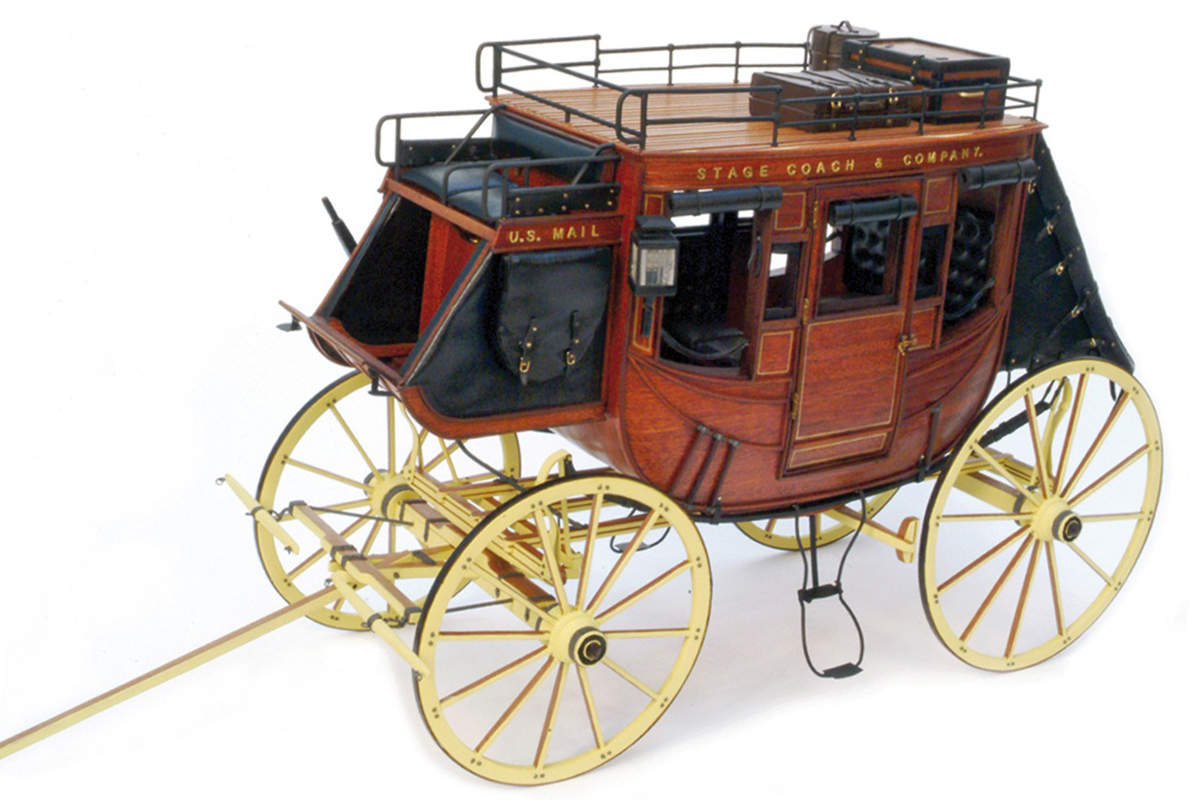
What is a stagecoach?
Simply put, a stagecoach is a closed, four-wheeled passenger transporting vehicle, drawn by two or more horses or mules. The driver, or coachman, sits at the front of the coach, high enough to have a clear view of the path and surrounding landscape. What sets stagecoaches apart from other coach types is that they were designed for longer distance travel along a predetermined route. Established stage stations or posts provided taverns and lodgings for travellers, and allowed for the replacement of tired horses with fresh ones.
In the late 19th century and beyond, armed “shotgun messengers” accompanied stagecoaches in order to protect valuables kept in strongboxes. The term “riding shotgun” originated from shotgun messengers, who typically sat alongside the driver at the front of the stagecoach.
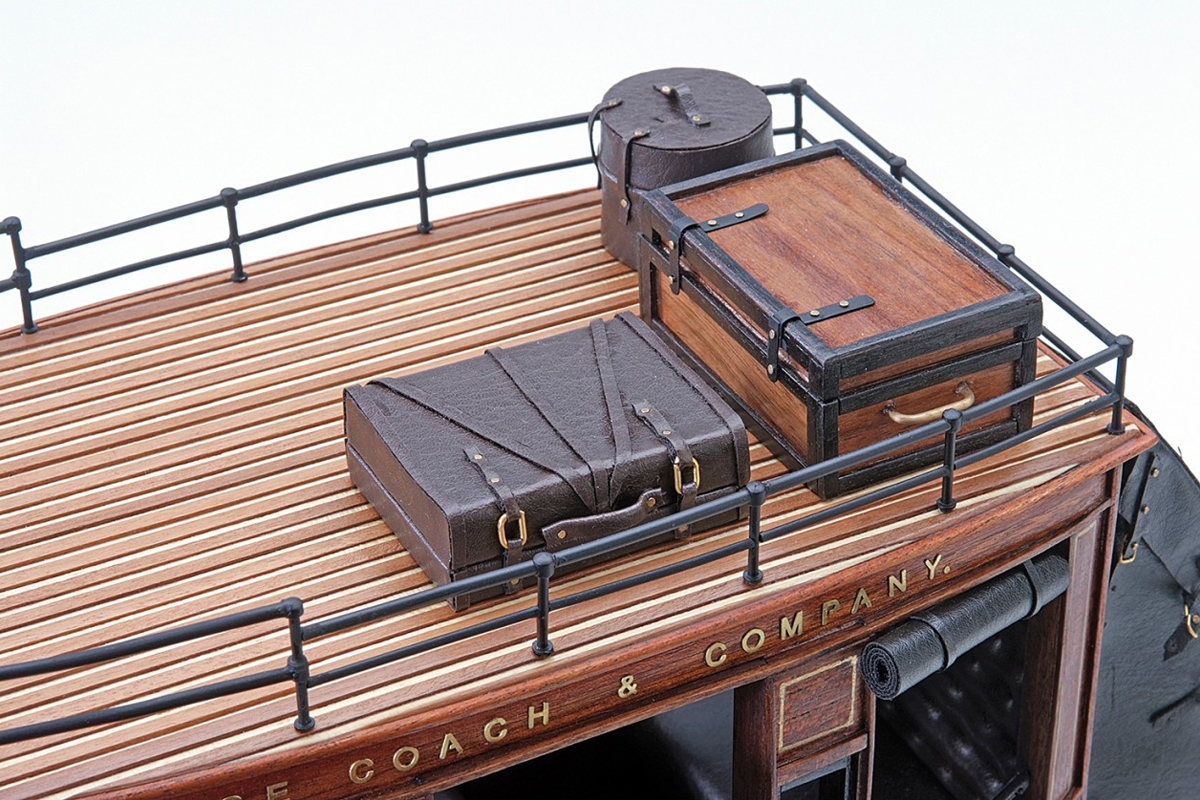
Stagecoaches in the US
On May 13th, 1718, the first stagecoach trip was completed between Boston and Providence, Rhode Island. Owned by Jonathan Wardwell, this successful voyage established what would become a major mode of transport for the better part of two centuries. The first regular stagecoach trips were limited to New England, but by 1756 this had expanded to include Philadelphia and New York. Such was the success of this new transportation system, that individual post riders were replaced by mail coaches by the late 18th century. With the significant impact of inclement weather, rocky and dangerous terrain, and bandits, stagecoaches provided a more stable and secure solution for mail delivery.
Despite their success, stagecoaches were still an uncomfortable experience for most, largely due to the use of steel and iron springs. In 1827, the Concord stagecoach changed things dramatically. The introduction of leather straps beneath the coach created a swinging motion, making the travelling experience far more pleasant.
In Mark Twain’s semi-autobiographical book, Roughing It (1861), he described a ride in the Concord stagecoach as “a cradle on wheels”
Stagecoach robberies
With the rise and prominence of stagecoaches, came the rise of bandits and robbers. Certainly, coach travel was safer than going it alone on horseback, but the success of companies like Wells Fargo drew unwanted attention. The impact and frequency of robberies was so bad during the gold rush era in the Rocky Mountains, that Wells Fargo took increasingly extreme measures to try to protect its passengers and payloads. They hired armed guards, nailed safes to floorboards, and trained silver merchants to create metal bars too heavy for robbers to carry. These measures did not stop bandits though, and Wells Fargo eventually established a detective agency to bring them to justice. This finally did the trick, but the cost of hiring these detectives matched the amount lost to robberies in the first place!
The arrival of the transcontinental railroad in 1869 signalled the beginning of the end of the US stagecoach era, however stagecoaches continued to be utilised for many more years in areas with limited railroad access. The automobile’s emergence was the final nail in the coffin. Despite being replaced by superior transport technology, the memory and legacy of the iconic stagecoach lives on. A symbol of America’s pioneering spirit, it improved cross-country travel dramatically and helped move the country into the future.
RELATED ARTICLES MORE FROM AUTHOR

Valentino Rossi bikes collection

Volkswagen vans old models from 60’s and 70’s
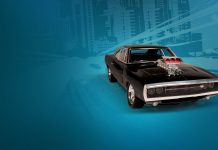
Tips and Tricks for Building Model Cars
No comments, leave a reply cancel reply.

Block title
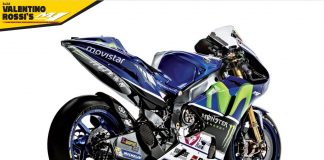
STAY CONNECTED
© 2024 De Agostini UK Ltd
- International Delivery
- Cancellation
- Ask our community
- Why ModelSpace?
- Privacy & Cookie Policy
- Acceptable Use Policy
- Terms & Conditions
- Google plus
© 2024 De Agostini UK L td
- Advertise with us
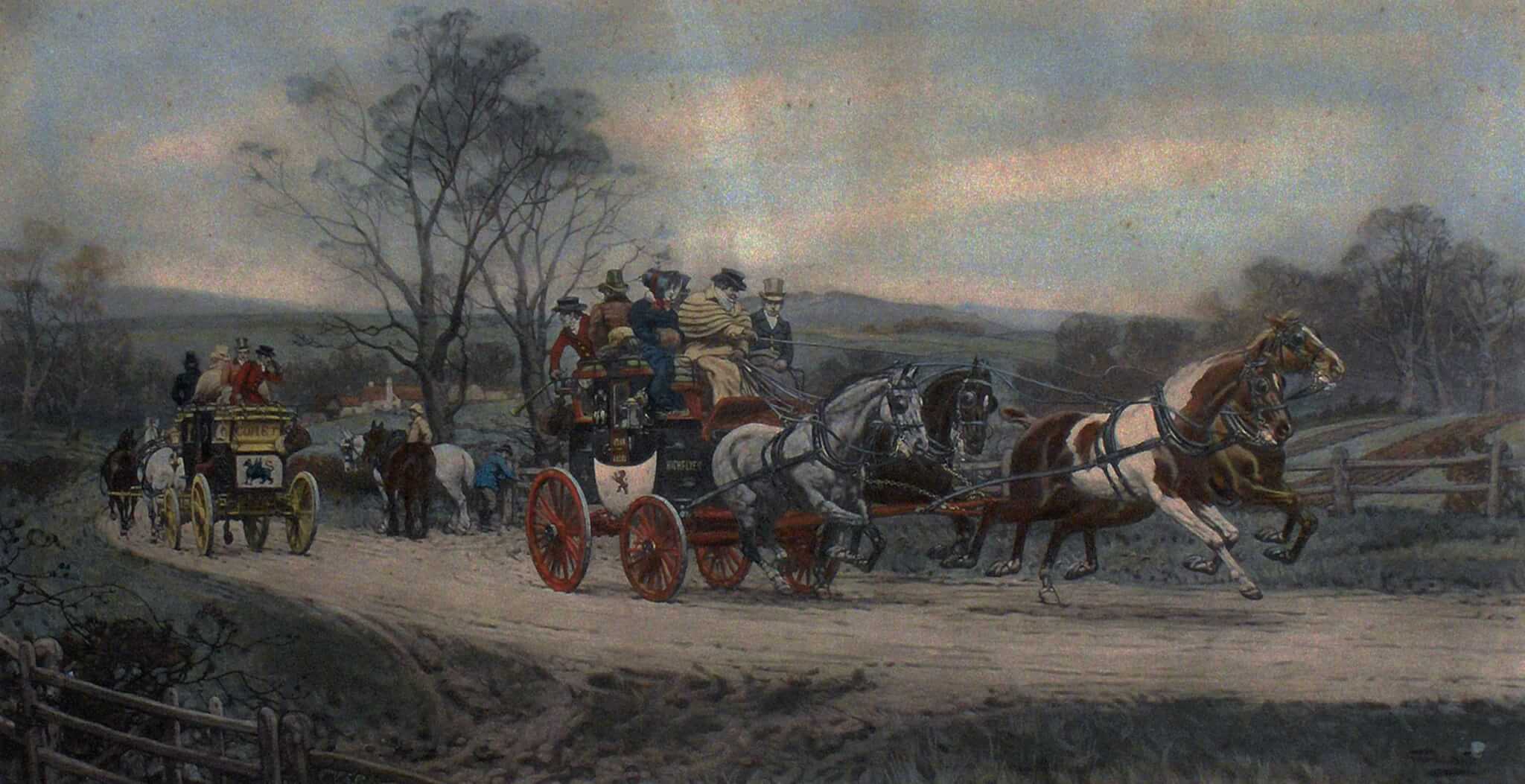
- History Magazine

The Stagecoach
The stagecoach was the most popular mode of transport for people and goods in Britain in the 17th, 18th and…
Ben Johnson
Originating in England in the 13th century, the stagecoach as we know it first appeared on England’s roads in the early 16th century. A stagecoach is so called because it travels in segments or “stages” of 10 to 15 miles. At a stage stop, usually a coaching inn, horses would be changed and travellers would have a meal or a drink, or stay overnight.
The first coaches were fairly crude and little better than covered wagons, generally drawn by four horses. Without suspension, these coaches could only travel at around 5 miles an hour on the rutted tracks and unmade roads of the time. During cold or wet weather, travel was often impossible. A writer of 1617 describes the “covered waggons in which passengers are carried to and fro; but this kind of journeying is very tedious, so that only women and people of inferior condition travel in this sort.”
The first stagecoach route started in 1610 and ran from Edinburgh to Leith. Early coach travel was slow; in 1673, it took eight days to travel by coach from London to Exeter! However the formation of a stage company in 1706 established a regular coach route between York and London and soon there were regular coach services on many other routes.
Coaching inns sprang up along these routes to service the coaches and their passengers. Many of these inns are still trading today: they can be recognised by the archways which allowed the coaches to pass through into the stable yard behind the inn.
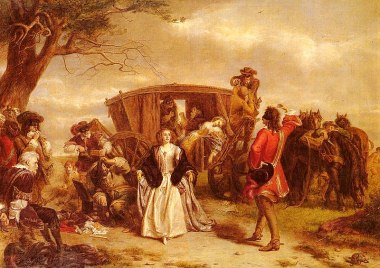
In the 17th and 18th centuries, stagecoaches were often targeted by highwaymen such as Dick Turpin and Claude Duval. Today we have rather a romanticised notion of highwaymen with their cries of ‘Stand and Deliver!’, but in reality these masked men terrorised the roads of England. The punishment for highway robbery was hanging and many highwaymen met their maker at the gallows at Tyburn .
In 1754, a company in Manchester began a new service called the “Flying Coach”, which it claimed would (barring accidents!) travel from Manchester to London in just four and a half days. A similar service began from Liverpool three years later, using coaches with the new steel spring suspension. These coaches reached the great speed of 8 miles an hour and completed the journey to London in just three days.
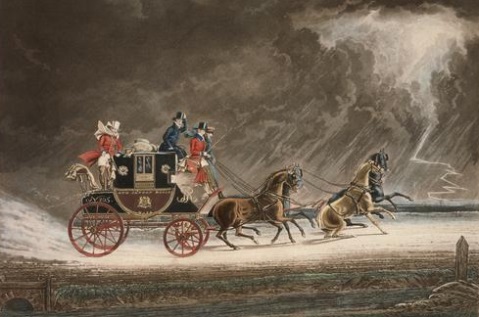
The development of the stagecoach also had a big impact on the postal service. Introduced in 1635, riders carrying the mail rode between ‘posts’ where the postmaster would take the local letters and then hand the remaining letters and any new ones to the next rider. This system was less than perfect: the mail riders were often targeted by robbers and the delivery of the mail was slow.
It was therefore decided to introduce mail coaches to transport letters and parcels in a faster, safer and more efficient way. By 1797 there were forty-two coach routes throughout the country, linking most major cities and carrying both stagecoaches and mail coaches.
The Regency period saw great improvements in coach design and road construction, leading to greater speed and comfort for passengers. For example, in 1750 it took around 2 days to travel from Cambridge to London but by 1820 the journey time had been slashed to under 7 hours.
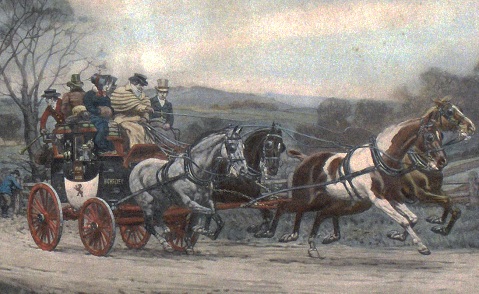
This was the golden age of the stagecoach. Coaches now travelled at around 12 miles per hour, with four coaches per route, two going in each direction with two spare coaches in case of a breakdown.
However the development of the railways in the 1830s had a huge impact on the stagecoach. Stage and mail coaches could not compete with the speed of the new railways. Soon the post was travelling by rail and by the mid 19th century, most coaches travelling to and from London had been withdrawn from service.
History in your inbox
Sign up for monthly updates
Advertisement
Next article.
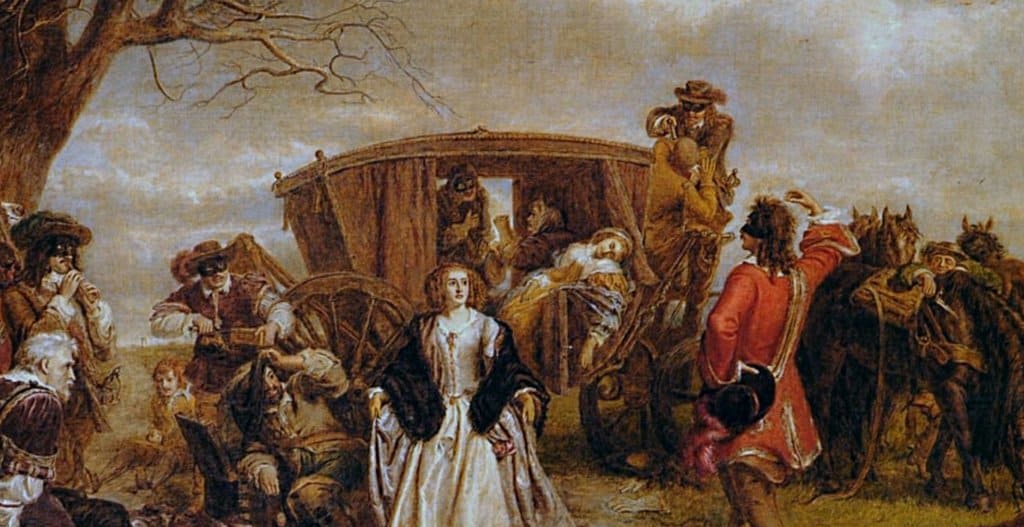
Stand and deliver! The history of British highwaymen - gentlemen of the road or thugs and thieves?
Popular searches
- Castle Hotels
- Coastal Cottages
- Cottages with Pools
- Kings and Queens

Legends of America
Traveling through american history, destinations & legends since 2003., the overland trail across the american west.

Stagecoach on the Overland Trail near Laramie, Wyoming.
By Grace Raymond Hebard and Earl Alonzo Brininstool 1922, with additional edits/information by Legends Of America.
The Overland Trail, also known as the Overland Stage Line, was a stagecoach and wagon road in the American West . Portions of the route had been used by explorers and trappers since the 1820s, especially along what would later become the California , Oregon , and Mormon Trails . Ben Holladay established the Overland Trail Mail route in 1862, closely following the Pony Express Trail .
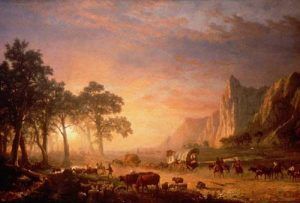
Oregon Trail, Albert Bierstadt, 1869
As the Oregon Trail widened and became deeper in the mountains and on the plains, many people eventually did not have the Pacific Coast in mind for their destination. Gradually, men and families unyoked their oxen, unharnessed the horses, and prepared to make a home in those sections most attractive in what was named and known as “ The Great American Desert .” As more and more people came to claim free land, isolated towns sprung up, and civilization pushed west. However, most of these new settlements were camps in the mining districts.
The necessity for safer and better transportation of supplies to these mining camps became most urgent. One of these places was Sacramento , at the end of the California branch of the Oregon Trail and the center of the early gold excitement in California.
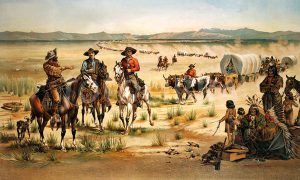
A wagon train and Indians
After more gold was found in the inland territories of Idaho , Utah , Montana , and Colorado , new trails were blazed. The government did not construct these but were side routes from the main trails made by the men seeking gold. As a logical outcome of the constant need for food, clothing, and tools, an organized movement started to have supplies transferred from the Missouri River to the wealth-bearing mountains.
Over the Oregon Trail, supply caravans or wagon trains made their way through a country that had been earlier pronounced as “only fit for prairie dogs and Indians .” Most people who came to the mountains in the earliest days did not go into agriculture or other occupations but went there to find gold or silver. To have things to eat and wear, tools for digging the ore, horses, and mules to operate the heavy work of the mines, and food for these working animals, made the commerce of freighting an absolute necessity. Wagon traffic was to supply necessities and luxuries for the West and on the isolated portions of the plains or in the hidden passes in the mountains.
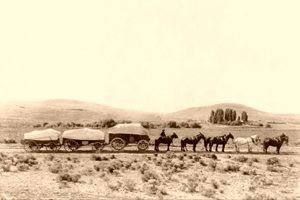
Freight Team on the Plains
Before establishing the regular freight trains, individual families on their way to the West banded together for self-protection from the hostile Indians. How commerce could be extended to those who had pushed into the unoccupied lands received the perplexing consideration of those who were to make the journey and the companies doing a transporting business.
Finally, the people of the Pacific coast demanded that the government take the necessary steps toward establishing a mail route across the mountains and the plains. When Utah was created as a territory, the people had to wait for the official Act of Congress from September 1850 to January 1851 because the documents traveled via the Panama route to California and then east back to Utah. In July 1850, the first mail route of monthly service was established between Independence , Missouri , and Salt Lake City , Utah, where it met an extension line going to California.
Alexander Majors, in 1858, when helping the government fill its contracts to carry supplies to Utah, used 3,500, 4,000 men, 1,000 mules, and more than 40,000 oxen. In May 1859, people such as Horace Greeley, Henry Villiard, and Albert D. Richardson rode into Denver on Majors’ first stagecoach, “Horsepower Pullman,” making 665 miles in six days, a distance that previously had been covered in 22 days. This first through stagecoach made the trip of 600 miles between Denver and Salt Lake “without a single town, hamlet or house being encountered on the way,” there being, of course, a few necessary stage stations.
Efficient mail service to the far West also occurred in 1858, when the Butterfield Southern Overland Mail route was implemented. The mail was first sent only semi-weekly but soon changed to six days per week. This route was 2,759 miles long, going by way of El Paso, Texas , to Yuma, Arizona , and then to California , making the journey, under favorable conditions, in 23-25 days. The letters cost 10¢ per half an ounce, and passengers paid a fair of $100. The one great advantage of this route over other routes was that it was so far south that it avoided the snow found on northern trails.
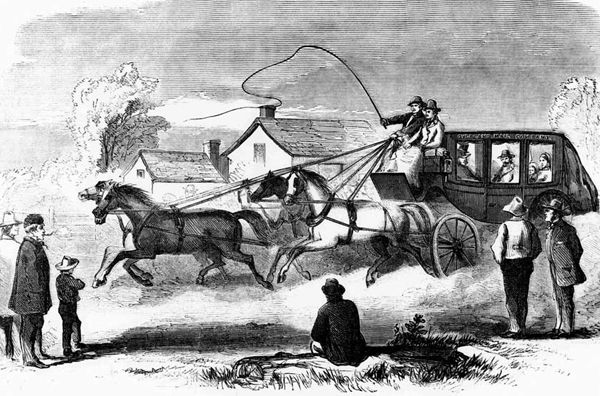
The Butterfield stage starts its journey in Tipton, Missouri.
This stage line was 40% longer than any other established stage line , an expensive affair from the mere fact of its unusual length. The road’s equipment was also costly, for it contained 100 Concord coaches, 1,000 horses, 500 mules, 750 men, and 150 drivers. When the Civil War began in 1861, it forced the government to change the route to a more northern territory, selecting the Overland Trail as a new road to run from St. Joseph , Missouri , to Placerville , California, which became known as the “Central Route.”
Central Overland California and Pikes Peak Express Company then ran mail stages over the Oregon Trail, simultaneously east and west. Each stage made the journey in 18 days, compared to 25 days over the southern route. The fare for the trip across the plains from Atchison , Kansas to Placerville , California, in the early 1860s was $600, including 25 pounds of baggage. Any excess baggage cost $1 per pound.
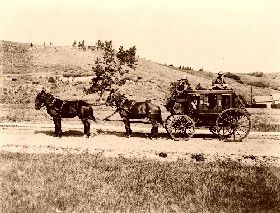
Stagecoach with a guard sitting on top, protecting whatever wealth it might have been carrying.
But the lumbering stages were too slow in their mail transportation to the impatient, news-hungry people of California, demanding that a more speedy method to carry the mail must be found.
As a result of persistent demand, through the efforts of William H. Russell, the Pony Express was established, which carried mail to California in 10 days. The road for the Pony Express, from St. Joseph, Missouri to Placerville, California, a distance of almost 2,000 miles, followed the Oregon and Mormon Trails to Salt Lake City and the Central Nevada Route to Sacramento. The horses employed were all small and of a western breed. There were 500 of them, and the riders were light of weight to match their mounts.
The company operating the Pony Express had 200 station-keepers and 190 stations at which the 80 riders were given only two minutes to change horses and transfer their saddlebags of mail. The stations were nine to 15 miles apart, depending on the water’s proximity.
Letters, costing $5 a half-ounce, were limited to 15 pounds for the average rider, the weight equally divided into two flat leather securely locked mail pouches. During the years of operation of the Pony Express, from April 23, 1860, to October 22, 1861, the mail was lost but once, when the Indians stole it.
The relay riders’ best time with this overland service was seven days and 17 hours when President Abraham Lincoln’s inaugural message was whisked over the route. There is no more picturesque achievement of the plains than the operation of the Pony Express, which shortened the time for Pacific mail service, thus bringing the people of the coast many days nearer to their former homes and the national government.
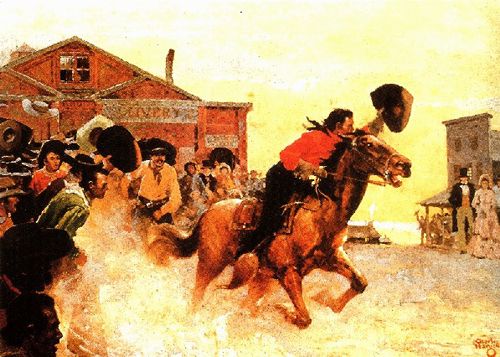
First Ride of the Pony Express
General John Reynolds, when at his winter headquarters in 1859-60, not far from the junction of Deer Creek with the North Platte Rivers, on the south side of the Oregon Trail , was one of the first west of Fort Laramie , Wyoming , to receive mail utilizing the Pony Express .
“The Pony Express was established while we were in winter quarters, and by it, we several times received interesting news but three days old. The sight of a solitary horseman galloping along the road was in itself nothing remarkable, but when we remember that he was one of a series stretching across the continent and forming a continuous chain for two thousand miles through an almost absolute wilderness, the undertaking was justly ranked among the events of the age, and the most striking triumph of American energy.” — General John Reynolds
But, the Pony Express lasted only a year before Central Overland California, and Pikes Peak Express Company went bankrupt, and the assets were sold to Ben Holladay .
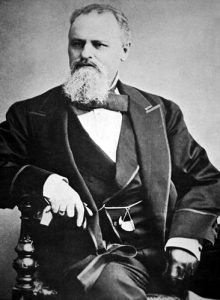
Ben Holladay
In 1861, Holladay was awarded the Postal Department contract for overland mail service between the end of the railroad’s western terminus in Missouri and Kansas and Salt Lake City. Service from Utah to California was given to the Overland Mail Company and other stage lines .
With the discovery of gold in Colorado and the consequent growth of the city of Denver , Holladay changed the Overland Trail to the West, using the banks of the South Platte River, as well as those of the North Platte, as a thoroughfare descending into Colorado before looping back up to southern Wyoming and rejoining the Oregon Trail at Fort Bridger , Wyoming . Due to Indian uprisings occurring on the Oregon Trail farther north through central Wyoming along the Sweetwater- South Pass route, the new route became the only emigrant route on which the US Government would allow travel and consequently was the principal corridor to the west from 1862 to 1868.
Between 1861 and 1866, Holaday operated about 5,000 miles of stagecoaches daily, having equipment of 500 coaches and express wagons, 500 freight wagons, 5,000 horses and mules, and numerous oxen. The cost to take care of this company’s stock averaged a million dollars annually, while to equip and run the line for the first year incurred the added expense of $2,425,000. After five years of freighting, Holladay sold out his entire business to the Wells Fargo Company, which remained an active operation until 1869 in that particular transportation line, when the Union Pacific and Central Pacific Railroads were completed. Holladay, in 1865, to help out the Overland Route to the Montana goldfields, established a branch line of his road from Fort Hall , Idaho , north to Virginia City , Montana. In addition to freighting, Holladay carried the mail for the government during the Civil War , receiving annually one million dollars for the service. Statistics show that in 1861 over 21 million pounds of freight went west from the shipping points of Atchison , Kansas , which brought with it to the plains using 4,917 wagons, 6,164 mules, 27,685 oxen, and 1,256 men.

The Overland Trail close followed the Pony Express Route, drawn by William Henry Jackson, 1860
For many years, Russell, Majors, and Waddell , the government contractors to transport military supplies to the forts along the trails, used in their trail-freighting train, 6,250 over-sized wagons, with a carrying capacity of 6,000 pounds each, and 75,000 oxen. This array of transportation facilities, if placed one in front of the other, would have covered the trail for a stretch of 40 miles. After a reliable freighting system was in place, it was not uncommon to see over 1,000 of these patient, plodding ox teams stretched across the plains each week, with wagons loaded many feet beyond the side-boards.
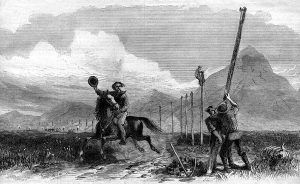
The Pony Express was running while the telegraph lines were being built. This drawing by George M. Ottinger appeared in Harper’s Weekly , 1867.
The extension of the telegraph line across the continent, under the management of Edward Creighton, in 1861 was the undoing of the Pony Express, which had been inaugurated to have a better and more rapid mail service from the Missouri River to San Francisco . The telegraph was put into operation on October 24, 1861, when the first transcontinental message was flashed over the line. Thus, an unprecedented step was taken in binding and uniting the Missouri River with the Pacific Ocean. This telegraph line ran parallel with and over the Oregon Trail. It soon became to the Indians a symbol of the white man’s despotism and his determination to finally possess the country through which the singing wires had spun their way to the lands of the mining camps and new mountain homes.
There were established two stage and telegraph lines from the Missouri River, one running from Fort Leavenworth , Kansas , to Fort Kearny , Nebraska , and the other from Omaha to Fort Kearny, Nebraska.
At Fort Kearny, the lines consolidated, going up the Platte Valley as far as Julesburg , Colorado , a conspicuous stage station near the mouth of Lodge Pole Creek, where it emptied into the Platte River. The lines again separated at this characteristically busy border town, the main telegraph line going north-westward to Fort Laramie , Wyoming, and beyond to South Pass and Utah . In contrast, the stage line went southwestward to Denver, Colorado, using the South Platte River. From Denver, the coaches went north to Fort Collins, then to Virginia Dale , Colorado, across the Laramie Plains, Fort Halleck, Elk Mountain, Bridger’s Pass, Bitter Creek, out to Fort Bridger , on to Utah , California , Oregon , and Montana . Just east of Fort Bridger, the Oregon Trail and the Overland Trail united and became one.
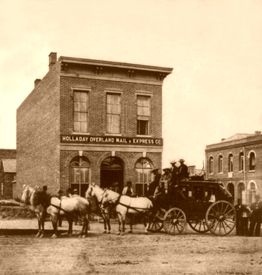
Holladay Overland Mail and Express Company in Denver, Colorado, about 1865
The route of the stage lines crossing these savagely contested lands had stage stations situated about every 12 miles along their length, while the government troops were posted along the route at specially constructed forts or blockhouses at intervals of about 100 miles. The scarcity of soldiers , particularly during the Civil War , available for this dangerous duty made the lives of the few who served one of extreme danger. Only a few armed and trained men were distributed at each station. In addition to these fortified buildings along the way were the occasional farmer and ranchman, the relay stations for changing horses, and the eating houses.
The shrewd Ben Holladay maintained a virtual monopoly of the Overland Stage line until 1866, when he decided to sell out. Well aware that the inevitable completion of the new Transcontinental Railroad would eliminate the need for stagecoach transportation, Holladay was fortunate to be able to sell the route, the equipment, and the contracts to Wells Fargo . The overland mail continued for another 2 1/2 years along the Overland Trail until the Union Pacific, and the Central Pacific railroads met at Promontory Point, Utah , in 1869, eliminating the need for mail service via the stagecoach.
The Overland Trail was most heavily used in the 1860s as an alternative route to the Oregon, California, and Mormon trails through central Wyoming.
It was a colossal business to supply those things most needed for the towns and cities that were springing into existence in the West, and the Oregon Trail became broader and deeper. This mighty traffic scarred the face of the trail to the West so deep that in many places, for miles, there remained discernible traces of the heavy traffic of this period, even after more than 50 years of disuse.
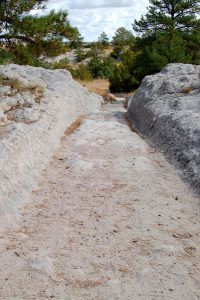
Oregon Trail Ruts in Wyoming By Kathy Alexander.
Compiled and edited by Kathy Alexander / Legends of America , updated June 2022.
Adventures & Tragedies on the Overland Trail
Stagecoaches of the American West
Stagecoach Kings (Lines) & Drivers
Wagons and Stagecoaches Photo Gallery
Source: Much of this article was written by Grace Raymond Hebard and Earl Alonzo Brininstool who were western historians in the early 20th century. This account was excerpted from their book, The Bozeman Trail: Historical Accounts of the Blazing of the Overland Routes Into the Northwest , published by the Arthur H. Clark Company in 1922. However, the article as it appears here has been heavily edited for spelling and grammatical corrections, truncated, and additional information has been added.
Other Sources:
Overland Trail Wikipedia
Valley Music Travel , powered by On Location , provides Ultimate Event Experiences in the Coachella Valley for fans like you looking to enhance the way you enjoy your passion. VMT provides a full range of services, from travel packages to shuttles to Safari tent camping – all with premium guest service. Don’t just attend an event. Experience it.

Platinum Services
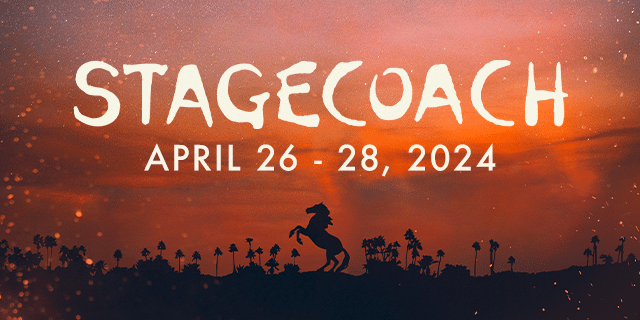
Get back to country music paradise with a little help from Valley Music Travel
Thank you for visiting!
Sign up to receive the latest info and updates:.
Stagecoach 2024: How to stream Morgan Wallen, Miranda Lambert and other sets at home

- Show more sharing options
- Copy Link URL Copied!
Tens of thousands of people are dusting off their cowboy hats as the 2024 Stagecoach festival returns to the Empire Polo Club in Indio this weekend.
But if the heat and the high wind advisory (not to mention the ticket and hotel prices) are keeping you out of the desert, you can still watch your favorite country artists from home — while keeping an eye out for a “Cowboy Carter” cameo.
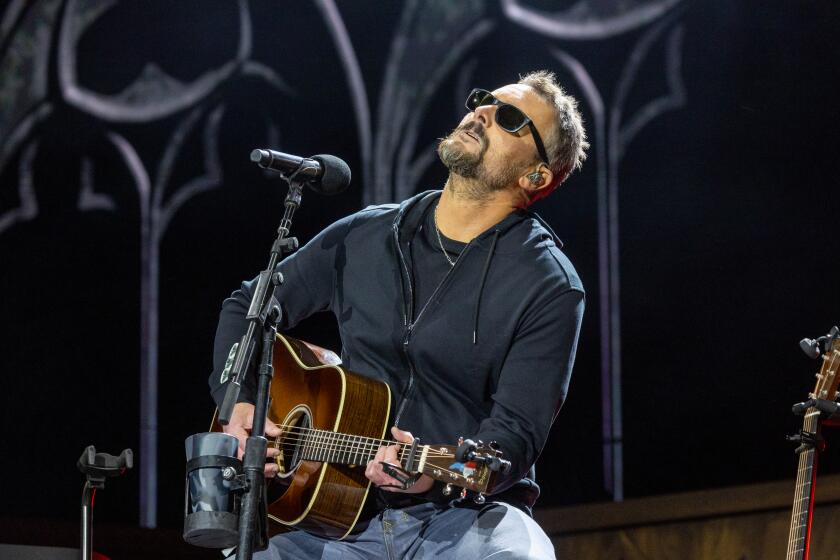
The best, worst and weirdest of Stagecoach Day 1 with Eric Church, Jelly Roll and more
From Jelly Roll’s big night and Eric Church’s somber set to Dwight Yoakam’s flying fringe, these are the biggest moments from Day 1 of Stagecoach 2024.
April 27, 2024
For the second year, “country music’s biggest party” will be livestreamed on the Amazon Music channel on Twitch.tv and via Prime Video starting at 4 p.m. PDT Friday and continuing Saturday and Sunday, starting at the same time. The livestream will include interviews with “Country Heat Weekly” podcast hosts Kelly Sutton and Amber Anderson as well as country radio personality and Bachelor Nation’s own Graham Bunn .
Don’t have access to Prime Video? You can access the livestream via a 30-day free trial of Amazon Prime.

The differences — and similarities — between the Coachella and Stagecoach festivals
The Stagecoach Country Music Festival is held in Indio at the same site as Coachella. What do the festivals have in common?
April 26, 2024
Fans also can purchase merchandise from more than a dozen performers, including headliners Eric Church, Miranda Lambert and Morgan Wallen, and listen to the official Stagecoach playlist at amazon.com/stagecoach .
And in case watching from your couch isn’t cutting it, a few last-minute one-day and three-day tickets to the sold-out event are still available at StubHub, Vivid Seats and SeatGeek, among other online ticket vendors.

Stagecoach 2024: Goldenvoice’s Stacy Vee on country music’s moment in the sun
Goldenvoice’s Stacy Vee talks about Stagecoach’s role in this hot country moment, how Black and Mexican traditions are shaping the genre, and more.
April 24, 2024
Stagecoach on Thursday announced a few additional sets aimed at its dance-pop-inclined attendees, including from emerging country artist Dasha, whose boot-stomping track “Austin” recently blew up on TikTok. Also gracing the stage at Diplo’s HonkyTonk, a tent dedicated to electronic dance and pop music, are Grammy–winning duo the Chainsmokers and DJ Marshmello.
All set times can be found on the Stagecoach website .

Morgan Wallen, Miranda Lambert and Eric Church to headline Stagecoach 2024
The eclectic country music fest will also feature performances from Jelly Roll, Hardy, Nickelback, Post Malone and 90-year-old Willie Nelson.
Sept. 7, 2023
More to Read

Post Malone’s all-star Stagecoach set includes Brad Paisley, Dwight Yoakam

Coachella and Stagecoach sound guy Dave Rat reveals the secrets to keeping the music crystal clear
April 22, 2024

The 15 best things we saw at Coachella 2024
April 15, 2024
The biggest entertainment stories
Get our big stories about Hollywood, film, television, music, arts, culture and more right in your inbox as soon as they publish.
You may occasionally receive promotional content from the Los Angeles Times.

Malia Mendez is an editorial assistant at the Los Angeles Times. She previously was an intern on the Entertainment and Arts Desk and recently graduated from Stanford University with a bachelor’s degree in English and a master’s degree in journalism. Mendez got her start in journalism at the Stanford Daily, where she worked as managing editor of the newspaper’s Arts & Life section. Her byline can be found in Los Angeles Magazine, the Orange County Register and the Peninsula Press. She is from Irvine.
More From the Los Angeles Times

A guide to everyone Taylor Swift sings about in ‘Tortured Poets Department’ — and their reactions

Entertainment & Arts
Review: ‘Illinoise,’ based on Sufjan Stevens’ concept album, clears a fresh Broadway path

‘Deeply disturbing’: Jeezy denies Jeannie Mai’s child neglect, domestic violence accusations

Ricky Martin to headline LA Pride in the Park festival
Music + Concerts | Stagecoach 2024: Eric Church’s performance…
Share this:.
- Click to share on Facebook (Opens in new window)
- Click to share on Twitter (Opens in new window)
- Click to share on Reddit (Opens in new window)
- Click to print (Opens in new window)
- Food & Drink
- Amusement Parks
- Daily News Store
Things To Do
Music + concerts, music + concerts | stagecoach 2024: eric church’s performance gets backlash from fans.
Not everyone was impressed with Eric Church’s Friday night headliner performance at the Stagecoach Country Music Festival , it seems, after many flocked to social media to express their disappointment in the set.
Eric Church might be the most disappointing festival headliner ive ever seen??? It’s like a gospel set?? I’m so lost. — kb (@KennethBaker97) April 27, 2024
The “Springsteen” and “Drink In My Hand” singer performed in front of a stained glass window -decorated stage with a gospel choir. Church mostly stuck to acoustic songs, many of which were covers.
As a huge fan, that was the most disappointing set I’ve ever experienced. — Michael (@dehardres) April 27, 2024
Much of the criticism revolved around the low-energy performance that rarely involved upbeat tempos or Church moving around the stage
Thank you! Music was beautiful but not the right venue! — msmilies☮️ (@msmiles13) April 27, 2024
Obviously Stagecoach didn’t learn their lesson from having Eric Church headline Friday night in 2016 and being a complete energy suck because he’s doing it again tonight. The stream not showing any crowd shots because they are probably leaving in droves 🤣 — Robert Wedge IV (@rtwedge4) April 27, 2024
Fans at Stagecoach shared videos that claim to show fans leaving Church’s performance early in droves.
@Stagecoach we paid $600 to see a headline where people are mass leaving… @ericchurch is a legend, but he hasn’t gotten off the stool and most songs are covers with the choir. This isn’t what we came for. pic.twitter.com/GcsMrqAIT7 — Anastassia Olmos (@StassiOlmos) April 27, 2024
This is the seen at Eric Church’s headliner set right now pic.twitter.com/ZBrtZx8z5G — Andrew Fig (@AndrewFig1010) April 27, 2024
Some fans disagreed with the rest, defending Church’s performance and applauding the singer for his authenticity.
Props to @ericchurch for keeping it real and bringing true artistry to @Stagecoach . He’s played there twice before so it was time to change it up. Masterful performance weaving in and out of spiritual tunes, soul tunes, hip hop, and his own songs. To all the haters, grow a pair. — Michael Millar (@michael_millar) April 27, 2024
Thought @ericchurch killed it tonight at @Stagecoach . I realize this isn’t a popular opinion on this Hellsite but if you recognize his extraordinary talent you’d realize how special this was. — Ray Zaborney (@raythemaverick) April 27, 2024
- Newsroom Guidelines
- Report an Error
More in Music + Concerts

Music + Concerts | Stagecoach 2024: Post Malone brings out Brad Paisley and more special guests

Music + Concerts | Stagecoach 2024: Fans attempt breaking Guinness World Record at festival

Music + Concerts | Stagecoach 2024: Day 2 of country music festival sure to hold surprises

Music + Concerts | Stagecoach: The New Bar brings fresh flavor, outlook on nonalcoholic drinks
Claudia Looi
Touring the Top 10 Moscow Metro Stations
By Claudia Looi 2 Comments

Komsomolskaya metro station looks like a museum. It has vaulted ceilings and baroque decor.
Hidden underground, in the heart of Moscow, are historical and architectural treasures of Russia. These are Soviet-era creations – the metro stations of Moscow.
Our guide Maria introduced these elaborate metro stations as “the palaces for the people.” Built between 1937 and 1955, each station holds its own history and stories. Stalin had the idea of building beautiful underground spaces that the masses could enjoy. They would look like museums, art centers, concert halls, palaces and churches. Each would have a different theme. None would be alike.
The two-hour private tour was with a former Intourist tour guide named Maria. Maria lived in Moscow all her life and through the communist era of 60s to 90s. She has been a tour guide for more than 30 years. Being in her 60s, she moved rather quickly for her age. We traveled and crammed with Maria and other Muscovites on the metro to visit 10 different metro stations.

Arrow showing the direction of metro line 1 and 2

Moscow subways are very clean
To Maria, every street, metro and building told a story. I couldn’t keep up with her stories. I don’t remember most of what she said because I was just thrilled being in Moscow. Added to that, she spilled out so many Russian words and names, which to one who can’t read Cyrillic, sounded so foreign and could be easily forgotten.
The metro tour was the first part of our all day tour of Moscow with Maria. Here are the stations we visited:
1. Komsomolskaya Metro Station is the most beautiful of them all. Painted yellow and decorated with chandeliers, gold leaves and semi precious stones, the station looks like a stately museum. And possibly decorated like a palace. I saw Komsomolskaya first, before the rest of the stations upon arrival in Moscow by train from St. Petersburg.
2. Revolution Square Metro Station (Ploshchad Revolyutsii) has marble arches and 72 bronze sculptures designed by Alexey Dushkin. The marble arches are flanked by the bronze sculptures. If you look closely you will see passersby touching the bronze dog's nose. Legend has it that good luck comes to those who touch the dog's nose.

Touch the dog's nose for good luck. At the Revolution Square station

Revolution Square Metro Station
3. Arbatskaya Metro Station served as a shelter during the Soviet-era. It is one of the largest and the deepest metro stations in Moscow.

Arbatskaya Metro Station
4. Biblioteka Imeni Lenina Metro Station was built in 1935 and named after the Russian State Library. It is located near the library and has a big mosaic portrait of Lenin and yellow ceramic tiles on the track walls.

Lenin's portrait at the Biblioteka Imeni Lenina Metro Station

5. Kievskaya Metro Station was one of the first to be completed in Moscow. Named after the capital city of Ukraine by Kiev-born, Nikita Khruschev, Stalin's successor.

Kievskaya Metro Station
6. Novoslobodskaya Metro Station was built in 1952. It has 32 stained glass murals with brass borders.

Novoslobodskaya metro station
7. Kurskaya Metro Station was one of the first few to be built in Moscow in 1938. It has ceiling panels and artwork showing Soviet leadership, Soviet lifestyle and political power. It has a dome with patriotic slogans decorated with red stars representing the Soviet's World War II Hall of Fame. Kurskaya Metro Station is a must-visit station in Moscow.

Ceiling panel and artworks at Kurskaya Metro Station

8. Mayakovskaya Metro Station built in 1938. It was named after Russian poet Vladmir Mayakovsky. This is one of the most beautiful metro stations in the world with 34 mosaics painted by Alexander Deyneka.

Mayakovskaya station

One of the over 30 ceiling mosaics in Mayakovskaya metro station
9. Belorusskaya Metro Station is named after the people of Belarus. In the picture below, there are statues of 3 members of the Partisan Resistance in Belarus during World War II. The statues were sculpted by Sergei Orlov, S. Rabinovich and I. Slonim.

10. Teatralnaya Metro Station (Theatre Metro Station) is located near the Bolshoi Theatre.

Teatralnaya Metro Station decorated with porcelain figures .

Taking the metro's escalator at the end of the tour with Maria the tour guide.
Have you visited the Moscow Metro? Leave your comment below.
January 15, 2017 at 8:17 am
An excellent read! Thanks for much for sharing the Russian metro system with us. We're heading to Moscow in April and exploring the metro stations were on our list and after reading your post, I'm even more excited to go visit them. Thanks again 🙂
December 6, 2017 at 10:45 pm
Hi, do you remember which tour company you contacted for this tour?
Leave a Reply Cancel reply
You must be logged in to post a comment.
Please go to the Instagram Feed settings page to create a feed.
Firebird Travel
RUSSIA TRAVEL HOME
Thank you for your enquiry.
RUSSIA TRAVEL PACKAGES A selection of Russian tours to take as they are or adjust to your needs.
THE GOLDEN RING Visit the heart of ancient Russia. What is the Golden Ring?
MOSCOW TOURS What you can see in Moscow.
MOSCOW DAY TRIPS Get out of Moscow and take a relaxing trip to some of these places
ST. PETERSBURG Some of the sights to see in Petersburg
LAKE BAIKAL TOURS Hiking and trekking around the world's deepest lake in the heart of Siberia
RUSSIAN DIGS Come and work in the field on a Russian Archaeological dig. Full training given on site.
TRAVEL TIPS & SERVICES Getting around in Russia
If you do not receive a confirmation email shortly then you have probably incorrectly entered your email.
Number of travelers ">
Special Interests or requests. "> ">
If you experience difficulties please use this link to send Regular Email . All information is treated as confidential

Taylor Swift, Travis Kelce Hit Vegas Hot Spot with Patrick, Brittany Mahomes

April Hot Shots … Celebs Ripped And Ready For Summertime!!!

Harry Jowsey Announces Skin Cancer Diagnosis
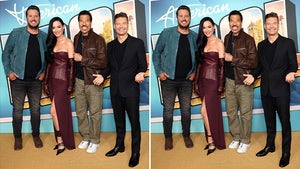
What's the Big Frigin' Difference?!

Noah Cyrus Blasts Troll with NSFW Comment After Family Love Triangle Joke
Stagecoach through the years ... yee haaaaw, stagecoach music festival through the years yeehaaaaw.
Grab a pair of boots and lasso up your favorite cowboy hat 'cause the 2024 Stagecoach Music Festival starts bucking in the desert today with country music's hottest stars headlining!
Eric Church , Miranda Lambert and Morgan Wallen will be closing out each day for all the country-crazed festival goers ... and there will be some epic alternative artists like Post Malone , Diplo and Wiz Khalifa to have you shakin' in your saddles ... but let's take a look back at the iconic moments that are STAGECOACH!
Travel all the way back to 2007 -- when Stagecoach first kicked off -- with our through the years gallery and see legendary show moments with Luke Bryan , Carrie Underwood , Snoop Dogg and many more idols!
Tennessee native Kelsea Ballerini has been "Unapologetically" herself since busting into the music scene in 2014, but she graced Indio, California in 2018 and was a contributing factor in setting a new attendance record of 75,000 Stagecoach attendees.
Shania Twain ain't no rookie when it comes to large crowds -- however, 2017 marked her first Stagecoach performance, but if you're gonna do Shania Twain, you better go BIG, and that's exactly why she was a headliner ... "Let's Go Girls!"
Waiting for your permission to load the Instagram Media.
Plus, you can't forget Diplo's HonkyTonk has its own lineup for the first time this year with Brandi Cyrus , James Kennedy and The Chainsmokers hitting the stage! The fest ropes in some of Hollywood's fun-lovers ... check out which celebs rode into the desert looking to wet their whistles and square dance with the best of 'em!
Hold on tight and enjoy the ride!
- Share on Facebook
related articles
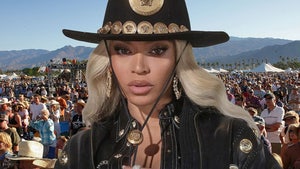
Beyoncé's Purported Secret Stagecoach Set Debunked by TikToker

Morgan Wallen Breaks Silence on Nashville Arrest, Chair Throwing
Old news is old news be first.
Music + Concerts | Stagecoach 2024: Fans attempt breaking Guinness…
Share this:.
- Click to share on Facebook (Opens in new window)
- Click to share on Twitter (Opens in new window)
- Click to share on Reddit (Opens in new window)
- Click to print (Opens in new window)
- Food & Drink
- Amusement Parks
- Theater & Arts
Things To Do
Music + concerts, music + concerts | stagecoach 2024: fans attempt breaking guinness world record at festival.

Festivalgoers at the Stagecoach Country Music Festival attempted to break the Guinness World Record for the largest gathering of people wearing double denim (tops and bottoms) inside Diplo’s Honkytonk at the Empire Polo Club in Indio on Saturday, April 27.
Unfortunately, the Wrangler-sponsored challenge came just 70 people short of breaking the record previously held by GAP Japan K.K in Japan, who broke it with 357 people back on January 31.
It seemed within grasp for the three-day event, where fans often sport western-themed fits. Right before the event began at the Honkytonk, which held a decent-sized crowd early in the afternoon, DJ 30Rack spun some tunes for the daily line dance lesson.

Festival goers try and break a Guiness World Record, for the “largest gathering of people wearing double denim,” during the Stagecoach Country Music Festival at the Empire Polo Club in Indio, Calif., on Saturday, April 27, 2024. (Photo by Jennifer Cappuccio Maher, Contributing Photographer)

Official Adjucator for Guiness World Record Tom Bradford counts festival goers as they try and break a Guiness World Record, for the “largest gathering of people wearing double denim,” during the Stagecoach Country Music Festival at the Empire Polo Club in Indio, Calif., on Saturday, April 27, 2024. (Photo by Jennifer Cappuccio Maher, Contributing Photographer)

Festival goers line dance while trying to break a Guiness World Record, for the “largest gathering of people wearing double denim,” during the Stagecoach Country Music Festival at the Empire Polo Club in Indio, Calif., on Saturday, April 27, 2024. (Photo by Jennifer Cappuccio Maher, Contributing Photographer)

Official Adjucators for Guiness World Record Tom Bradford, left, and Sarah Casson, prepare to count festival goers as they try and break a Guiness World Record, for the “largest gathering of people wearing double denim,” during the Stagecoach Country Music Festival at the Empire Polo Club in Indio, Calif., on Saturday, April 27, 2024. (Photo by Jennifer Cappuccio Maher, Contributing Photographer)

Fans who were there may not have not known the tally was scheduled for Saturday. As the line dancing ended, people began to leave, including folks sporting the denim-on-denim look.
Some, like Ashley McCollum of Thousand Oaks, heard about the denim record attempt through the Stagecoach mobile app, and her friend Tori Nguyen had seen it on her Instagram.
“I usually wear denim at least for one of my outfits when I come out here,” McCollum said. “This year, I had a jacket I was going to wear one day and then shorts for the next day, but when I saw the challenge, I just brought both.”
By 3 p.m., festival and Wrangler staff made a microphone announcement asking fans to head to the back of the Honkytonk, where they lined up and were then enclosed behind stanchions as official adjudicators for Guinness World Record using clickers kept count along with official stewards who observed groups of 50 or more waiting in the record attempt area.
The crowd’s outfits included different colored denim coats, shirts, shorts and pants, which were all counted. Other people wearing denim jumpsuits, overalls, and dresses were turned away, along with people who only had one denim clothing item. To make matters worse, people who left the record attempt area were deducted from the count.
“I think they were waiting for more people to come in, and some people wanted to see the artists performing,” said Sarah Casson, official adjudicator for Guinness World Record.
Tom Bradford, another official adjudicator for the Guinness World Record, said that these record-breaking events aren’t exclusive to music festivals and are sometimes organized specifically to try and snub the Guinness World Record, but it helps to have mass groups of people and ensure the message for the attempt gets out.
“From what I heard from people outside, was it very much like ‘Oh, I didn’t know about it’ or ‘If I had known, I would’ve been there,’ but harder at music festivals when there is so much going on, but we’re happy that these people came out and attempted to break the record,” Bradford said.
“It was a really fun event and valiant effort, and everyone seemed to enjoy themselves despite not being a successful attempt this time around,” Casson added.
- Newsroom Guidelines
- Report an Error
More in Music + Concerts

Music + Concerts | Stagecoach 2024: Post Malone brings out Brad Paisley and more special guests

Music + Concerts | Stagecoach 2024: Day 2 of country music festival sure to hold surprises

Music + Concerts | Stagecoach: The New Bar brings fresh flavor, outlook on nonalcoholic drinks

Music + Concerts | Stagecoach 2024: Diplo’s Honky Tonk stage brings line dancing, EDM acts to the country event
Eric Church sends Stagecoach festivalgoers for the exits with acoustic gospel set
Eric Church has a reputation for being one of country music's true rebels, with songs such as his quaking blue-collar anthem "How 'Bout You" that asks "I like my country rocking, how 'bout you?" But that's not the same guy who showed up to Stagecoach as a headliner on Friday.
For his seventh time playing the festival — and fifth time headlining — Church opted for something different.
After a lengthy church organ played as the intro, Church appeared seated on a stool in front of stunning set of red stained glass windows on the production screen.
He began playing Leonard Cohen's "Hallelujah" before he was joined by backing vocalists for "Mistress Named Music," then a choir for "Swing Low, Sweet Chariot," "This Little Light Of Mine," "When The Saints Go Marching In," "I'll Fly Away," "I Saw The Light" and more.
The unplugged jam session sent festivalgoers for the exit of the Empire Polo Club starting about 15 minutes in, a sight that could be best described as Moses parting the Red Sea. It was a surprising move by Church, considering his recent setlists appear to be in line with the type of show many were probably expecting him to perform.
There was a memorable moment when Church began singing a country and gospel version of Snoop Dogg's "Gin & Juice" and the line "I got a pocket full of rubbers and my homeboys too" never sounded more bizarre in the same set as gospel songs. He continued on with the potentially even more surprising choice of 2Pac's "California Love."
An hour and six minutes into the set, Church still hadn't said more than "How ya'll doin'?" but he did finally play his hit "Springsteen," one of the true highlights of the baffling set. The other highlight was the talented choir that joined him the entire set, along with longtime collaborator Joanna Cotten, and the various solos that many of the talented singers performed towards the end.
So why did he chose to do a gospel set with the occasional country ballad (and even some hip-hop hits)? I think we're all still curious what the meaning behind the set was, but it's clear he was trying for something different.
It wasn't bad, it just wasn't what people wanted.

IMAGES
VIDEO
COMMENTS
All of those things should be remembered when the romance of stagecoach travel comes to a grinding halt and reality rears up. Stage travel was one way to get from Point A to Point B or even Q in the Old West — stage companies hired drivers, guards, and set up waystations along the route for changes in horses and brief rest periods, perhaps even a meal.
Though stagecoach travel for passengers was uncomfortable, it was often the only means of travel and was safer than traveling alone. If passengers wanted to sleep, they were required to sit up, and it was considered bad etiquette to rest one's head on another passenger. There were also numerous other rules required of passengers, including ...
A stagecoach (also: stage coach, stage, road coach, diligence) is a four-wheeled public transport coach used to carry paying passengers and light packages on journeys long enough to need a change of horses. It is strongly sprung and generally drawn by four horses although some versions are drawn by six horses.. Commonly used before steam-powered rail transport was available, a stagecoach made ...
The Stagecoach in 1860s The Passenger Experience - by Jay W. Sharp. John Ford's motion picture, Stagecoach, his classic 1939 cinematic parable of the Old West, virtually defined the image we carry in our mind's eye of nineteenth century stagecoach transportation in the Southwest.This includes John Butterfield's Overland Mail Company stagecoach service, which connected St. Louis, Missouri, and ...
Stagecoach travelers in the 19th century faced challenges and dangers such as rough terrain, banditry, accidents, harsh weather conditions, poor sanitation, and health hazards. Despite these risks, stagecoach travel played a significant role in transportation during that era. The 19th century stagecoach revolutionized transportation and played ...
Stagecoach Robberies. Stagecoach travel could be dangerous, too. During the gold rush years in the Rocky Mountains the Wells Fargo line had such a difficult time protecting its passengers and cargo that it created a standard form letter for reporting robberies. Wells Fargo nailed safes to the floorboards of the coaches, hired armed guards to ...
The stagecoach was the major vehicle for overland group transport until railroads began to dominate in the 1850s. Rural inhabitants continued to rely on stagecoaches for local travel, and hotels sent them to meet trains or take guests sightseeing. Detailed Description. Make Cover Photo.
stagecoach, any public coach regularly travelling a fixed route between two or more stations (stages). Used in London at least by 1640, and about 20 years later in Paris, stagecoaches reached their greatest importance in England and the United States in the 19th century, where the new macadam roads made travel quicker and more comfortable. In the United States, coaches were the only means that ...
Stagecoaches in the US. On May 13th, 1718, the first stagecoach trip was completed between Boston and Providence, Rhode Island. Owned by Jonathan Wardwell, this successful voyage established what would become a major mode of transport for the better part of two centuries. The first regular stagecoach trips were limited to New England, but by ...
The first stagecoach route started in 1610 and ran from Edinburgh to Leith. Early coach travel was slow; in 1673, it took eight days to travel by coach from London to Exeter! However the formation of a stage company in 1706 established a regular coach route between York and London and soon there were regular coach services on many other routes.
Overland Trail. The Overland Trail (also known as the Overland Stage Line) was a stagecoach and wagon trail in the American West during the 19th century. While portions of the route had been used by explorers and trappers since the 1820s, the Overland Trail was most heavily used in the 1860s as a route alternative to the Oregon, California, and ...
STAGECOACH TRAVEL. STAGECOACH TRAVEL. Stagecoaches were familiar vehicles along the main roads of the East and the South before the coming of railroads in the 1830s and 1840s. Even as the nation's network of iron and steel rails grew larger and more comprehensive, stagecoach connections to small and isolated communities continued to supplement passenger trains well into the second decade of ...
Learn about the amazing feat of the Butterfield Overland Mail Stage. The stage operations, which began in 1858 between St. Louis and San Francisco, revolutionized mail and passenger service. Traveling 24 hours a day, the 2,800-mile trip took an unheard-of 25 days! The stage line forever changed travel and mail transportation.
The Overland Trail, also known as the Overland Stage Line, was a stagecoach and wagon road in the American West. Portions of the route had been used by explorers and trappers since the 1820s, especially along what would later become the California, Oregon, and Mormon Trails. Ben Holladay established the Overland Trail Mail route in 1862 ...
Stagecoach Lines. Stagecoach operations in Texas, as in other states, were closely tied to government mail contracts. These contracts provided the solid financial base that also allowed stage companies to transport passengers and freight. Stagecoach routes provided a nineteenth-century network making travel or mail delivery possible to all ...
Stagecoach. Get back to country music paradise with a little help from Valley Music Travel Go To On Location. Like Us on Facebook. Follow Us on Twitter. Follow Us on Instagram Join our mailing list > 888-833-1031. 10AM - 6PM ET, Monday - Friday. [email protected].
PIONEER STAGE-COACH TRAVEL'. By Louis PELZER. Pioneer transportation of the last century must pay tribute to. the steamboat, the canals, the stage-coach, and the railroad. Be- fore 1792 the vanguard of foot and horseba;ck travellers crossed the Alleghenies. lIater ox-drawn and horse-drawn vehicles a.d- vanced with every movement of the West.
Welcome to the Stagecoach bus travel portal, where you can plan your bus journey, buy bus tickets, find bus timetables, view live bus times, receive bus service update notifications, as well as a wealth of frequently asked questions and contact information.
Stagecoach 2024: Goldenvoice's Stacy Vee on country music's moment in the sun. April 24, 2024. For the second year, "country music's biggest party" will be livestreamed on the Amazon ...
Fans at Stagecoach shared videos that claim to show fans leaving Church's performance early in droves. @Stagecoach we paid $600 to see a headline where people are mass leaving…
Revolution Square Metro Station. 3. Arbatskaya Metro Station served as a shelter during the Soviet-era. It is one of the largest and the deepest metro stations in Moscow. Arbatskaya Metro Station. 4. Biblioteka Imeni Lenina Metro Station was built in 1935 and named after the Russian State Library.
In 1938, it was granted town status. [citation needed]Administrative and municipal status. Within the framework of administrative divisions, it is incorporated as Elektrostal City Under Oblast Jurisdiction—an administrative unit with the status equal to that of the districts. As a municipal division, Elektrostal City Under Oblast Jurisdiction is incorporated as Elektrostal Urban Okrug.
Plan your bus journey. Need to get somewhere without a fuss? Use our bus journey planner to find the best bus routes to get you there. All you need to do is pop a few details into our bus route planner to find routes, times and up-to-date service announcements. Remember to save your favourites to make it even quicker next time!
RUSSIA TRAVEL PACKAGES A selection of Russian tours to take as they are or adjust to your needs. THE GOLDEN RING Visit the heart of ancient Russia. What is the Golden Ring? MOSCOW TOURS What you can see in Moscow. MOSCOW DAY TRIPS Get out of Moscow and take a relaxing trip to some of these places.
Stagecoach 2024 kicks off today and will run through the weekend with Country music's hottest stars headlining! Travel all the way back to 2007 -- when Stagecoach first kicked off -- with our ...
Drive • 1h 3m. Drive from Elektrostal to Moscow 58.6 km. RUB 450 - RUB 700. Quickest way to get there Cheapest option Distance between.
PUBLISHED: April 27, 2024 at 7:12 p.m. | UPDATED: April 27, 2024 at 7:12 p.m. Festivalgoers at the Stagecoach Country Music Festival attempted to break the Guinness World Record for the largest ...
Eric Church sends Stagecoach festivalgoers for the exits with acoustic gospel set. Brian Blueskye. USA TODAY. 0:05. 1:40. Eric Church has a reputation for being one of country music's true rebels ...